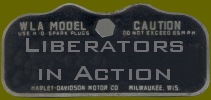

US Army WLAs in Wartime Photos and Publications
I assert the moral right to be recognized as the owner of the
images on this site (unless stated otherwise).
If you wish to use these photos for noncommercial purposes I consent to such use
as long as the source of the photos is clearly acknowledged.
'Presidential
Escort'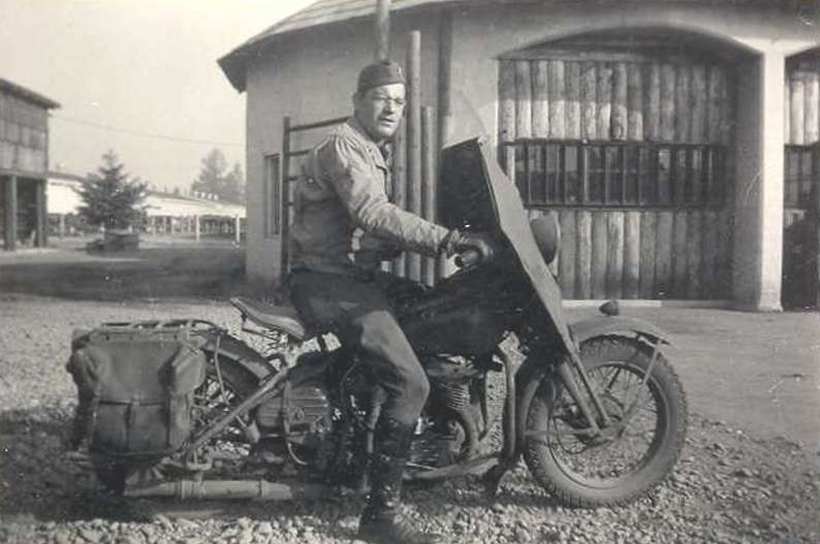 Photo: Joe Bennett via www.olive-drab.com |
|
Private Joseph L. Bennett
astride a Type I 41WLA at Fort Lewis, WA, late in 1942.
The longer forks and the extensions between the front mudguard and forks on the
41WLA are clearly visible, as well as the early pattern luggage rack, unique to
the 41WLA. |
|
|
'Stateside Manoeuvres' 1941-42.... Sylvester Bonacorso
rides his Type II 41WLA as a US Army Messenger during Army Manoeuvres early in
WW2. Pvt Bonacorso wears the complete wool Service Uniform
with Service Shoes and Leggins. Goggles are the Polaroid All Purpose Type,
worn with an unidentified piece of headgear. In the background is a GMC 2 1/2 Ton Truck. |
'Early War MPs'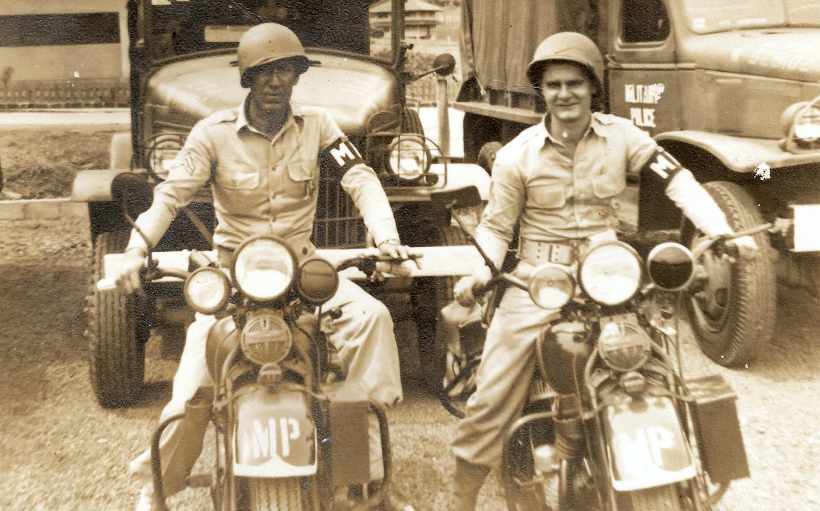 Photo from the Webmaster's Collection |
|
Two
Military Policemen straddle their shiny motorcycles early in WW2.
Both riders are wearing
the Summer cotton uniform with M1 helmet liners and MP armbands. In the background are a Dodge 1/2Ton Series WC23 Command Car and 1 1/2 Ton Chevrolet truck marked MILITARY POLICE on the side, typical vehicles of the era. |
|
'A New Ride' A GI poses on an early 42WLA motorcycle somewhere in the USA. The bike seems new and is a Type I 42WLA. The headlight is mounted high
and the picture clearly shows the early round Air Cleaner with large top
and instruction decal. The soldier is wearing the standard wool uniform of the era... The wooden barracks in the background are typical US Army lodging of the period. |
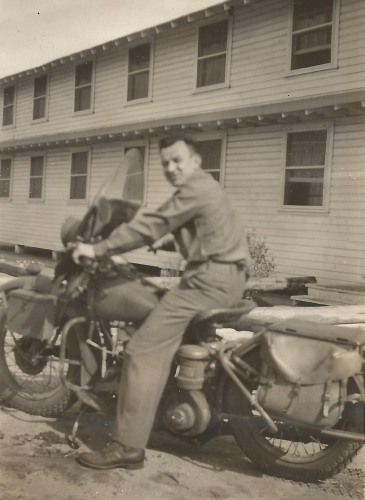 Photo from the Webmaster's Collection |
'Over the Bridge'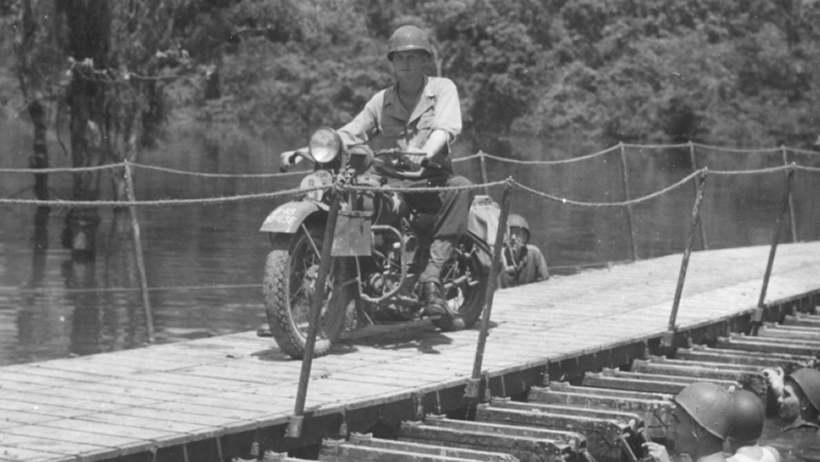 Photo from the Webmaster's Collection |
|
Un unidentified GI rides his motorcycle over a floating bridge during training. Engineers are in the water holding the bridge.
The motorcycle appears to be a Type I 42WLA with high mounted headlight. The
horn has the early cover with Harley-Davidson logo. A Black-Out Driving light
has been retrofitted as the Type I 42WLA was not factory equipped with
one. |
|
'Born
to Ride'... |
|
Converted from horses to speedy
steel, GIs of the 107th Cavalry Regiment, now on mechanised mounts, ride in a
mass column of 4s towards a new position.
The bikes on the first two rows
are Type I 42WLAs, while the third row holds at least two Indian Motorcycles. The uniforms are typical of the early war period, especially the 'Doughnut' Tanker Helmets.... Later in the war this picture was used for publicity purposes as shown at the bottom of this page and just maybe it was the inspiration for the 1991 movie 'Born to Ride'..... |
'Army
'Aero' Parachute Troops' ...'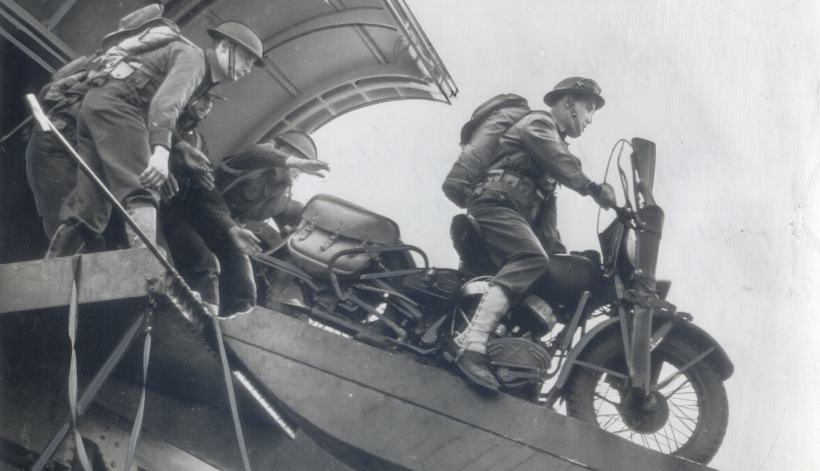 Photo from the Webmaster's Collection |
|
The
original caption of this picture dated 22nd April 1942 says: The motorcycle is clearly a Type II in new condition. The tan saddlebags seem empty and although the rifle scabbard is the M1904 model designed to hold the M1903 Springfield rifle, it seems the M1 Garand rifle is carried. Note the folded up footboards. At this stage of the war the men are still wearing early WW2 equipment including the M1917A1 'Kelly' helmet. |
'Take
Cover!...' US Army Signal Corps Photo / Webmaster's Collection |
|
During
training motorcycle riders were taught how to dismount rapidly by sliding the
bike on its side so they could take up a firing position behind it when falling
under enemy fire. The equipment and M1917A1 'Kelly' helmets worn by the riders show this picture was taken somewhere in the USA around mid 1942. Note the C47 transport planes in the background. |
|
'Training in the USA' This superb color image shows a GI taking aim with his Thompson M1928A1 SMG behind his WLA during an exercise in 1942.
He wears the HBT uniform with Hawley Fiber M1 helmet liner. An M1 Dust
Respirator is barely visible on his left cheek. The goggles are the M1938
Resistal type.
The motorcycle is a Type II 42WLA identified by the bicycle type starter
pedal and low headlight. Note the chafed side of the saddle, despite the
three rivets. The paint on the handlebar grip has nearly completely worn
off from extensive use. |
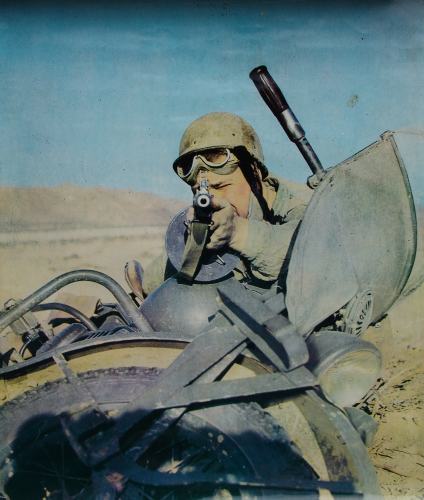 Photo from the Webmaster's Collection |
|
'Ride Out!' Two GI's on their rides, somewhere in the US. Bikes are either Type II or III 42WLA. No markings at all are visible. Note the rather casual Summer tan uniforms worn by both men: rolled up sleeves and a variety of headgear, rank insignia and shoes. The Corporal on the left wears a leather 'kidney' belt for additional support. |
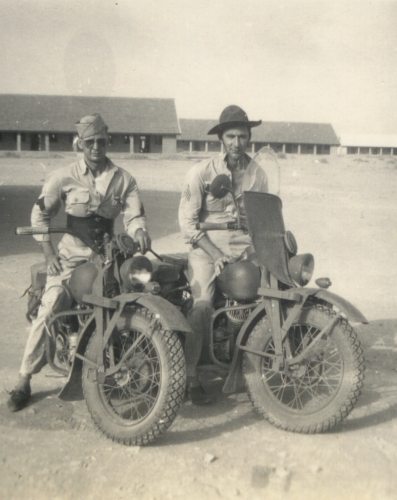 Photo from the Webmaster's Collection |
|
'Early War Maneuvers!' A Type II 42WLA is used as a photo prop during US Army maneuvers early in WW2. Another bike can be seen in the background; both motorcycles seem brandnew. Of special interest is the rectangular oil bath air cleaner first used on the Type II 42WLA. An instruction decal is applied to the filter body. Later instructions would be embossed on a separate plate which was spotwelded to the air cleaner and the last model would have the instructions embossed directly into the filter box. The GI astride the bike wears the standard cotton khaki uniform designed for Summer wear with smooth leather Service Shoes and Leggins. An early 2 1/2 Ton GMC Truck fitted with chevron pattern tires is parked in the background. |
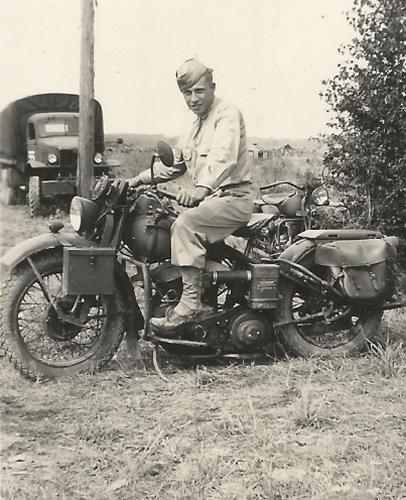 Photo from the Webmaster's Collection |
'Jump Around...'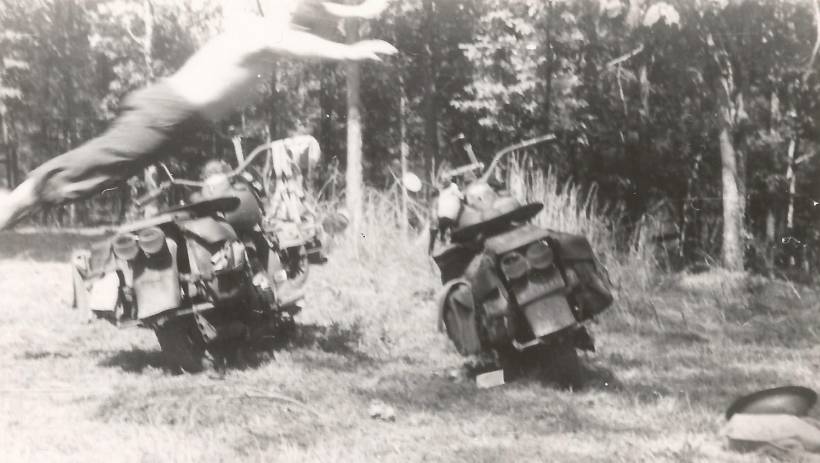 Photo from the Webmaster's Collection |
|
A GI
does some acrobatics during a field exercise in the United States early
in WW2. Both
bikes seem to be Type II or III 42WLAs and of special interest is the
Number Plate which bears a 'W' prefixed U.S.A. Registration Number on
the WLA on the right confirming the type. An M1917A1 'Kelly' Helmet can be seen in the foreground with some other uniform garments. This type of helmet was still used by troops in training early in WW2 and was replaced by the M1 Helmet as war progressed. |
|
'Motorcycle
Patrol' |
|
Military
Policemen on Type II 42WLAs patrol a US Army Camp during WW2. Both GI's are wearing the wool Service Uniform, with an MP Brassard barely visible on the rider on the left, and carry a M1928A1 Thompson Submachinegun on the right shoulder. The SMG Brackets do not hold the leather scabbards for the guns. |
|
'A Day out on our Bikes'
(US)' |
|
Three Military Policemen have parked their motorcycles
somewhere along the road to pose and get themselves photographed on their
rides.... |
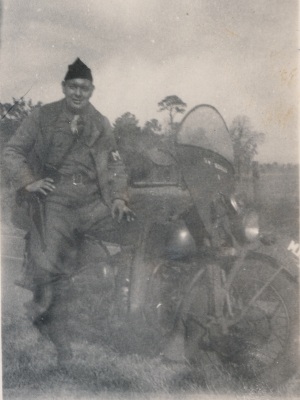
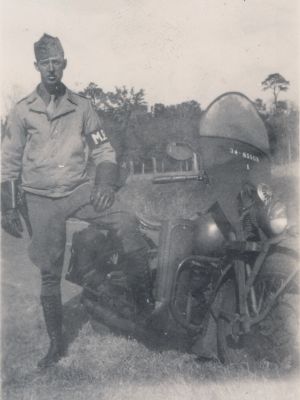
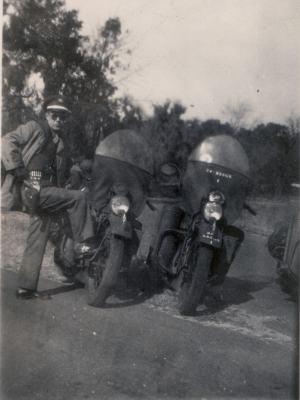
Photos from the Webmaster's
Collection
|
The above images show the MP's posing with the bikes. Two
of them wear breeches with high laced riding boots and all have the leather
Military Police equipment under their jackets, M1941 Field Jacket in the middle
with the other two wearing Mackinaw coats. Note the gloves on the GI in the
middle. |
'MP Motorhead!'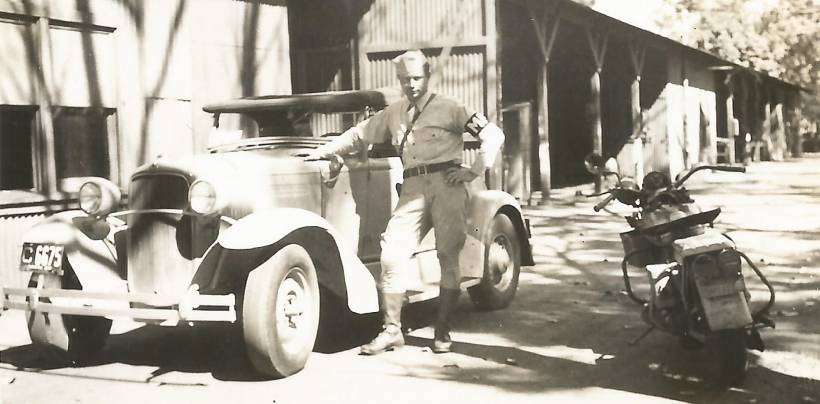 Photo from the Webmaster's Collection |
|
A
Military Policeman has parked his Harley to pose next to a 1932 Ford
Roadster somewhere in the USA. The
uniform worn by the MP is composed of the Summer Cotton Breeches with
shirt and Riding Boots. |
'Basic Training'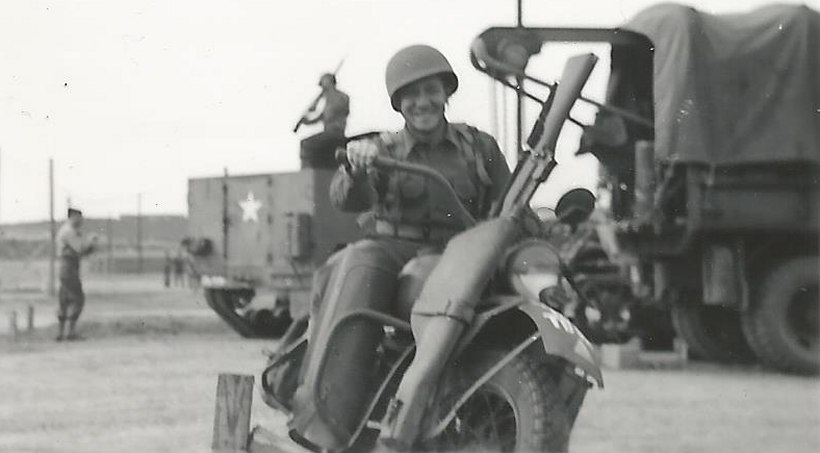 Photo from the Webmaster's Collection |
|
An
unidentified GI poses on a WLA during Basic Training at Camp Bowie,
Texas in December 1942. The WLA is equipped with legshields and a WW1 vintage M1917 Rifle is carried in the leather scabbard. Along with the M1903 'Springfield' Rifle, the M1917 was the main infantry weapon of the Great War and was still used for training in WW2. Most likely this soldier came across a parked motorcycle and put the rifle in the submachinegun scabbard while straddling the bike for the picture. It would have been extremely awkward to ride a WLA carrying the long M1917 rifle this way... The soldier wears the standard wool 'M1941' uniform of the era with an M1 helmet liner. Visible in the back ground are a Half-Track and GMC Truck fitted with a Number-7 Wrecker Set. |
|
'Somewhere in the 'Zone of the Interior'
(US)' |
|
An MP proudly poses between several WLA bikes at a US Army Camp during WW2.
The bikes all seem to be either Type II or III which could indicate the photo
was taken in 1943. All motorcycles are equipped with red pursuit lights and
legshields. Note the bicycle type starter pedal on the 2nd bike from the left
(Type II) and the white painted oil pump on the 3rd bike from the left. Only
one bike is marked and allows us to identify the unit. The Military Policeman wears the standard Wool Service Uniform with leather belt and shoulder strap supporting the .45Cal Pistol holster. Other MP equipment consists of an MP brassard, brass whistle and the rather rare Military Police Patrolman badge...! |
|
'Stateside MP' A Military Policeman rides a Type II WLA somewhere in the Continental US during WW2. The
bike lacks saddlebags and rifle scabbard but is fitted with legshields; no
luxury in the winter weather. The
rider, wearing the standard uniform of the period, is armed with a .45Cal
M1911A1 pistol carried in the M1916 Holster. Other motorcycles are parked in the background. |
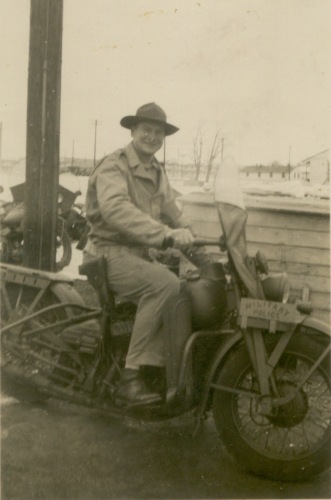 Photo from the Webmaster's Collection |
'At
the Motorpool'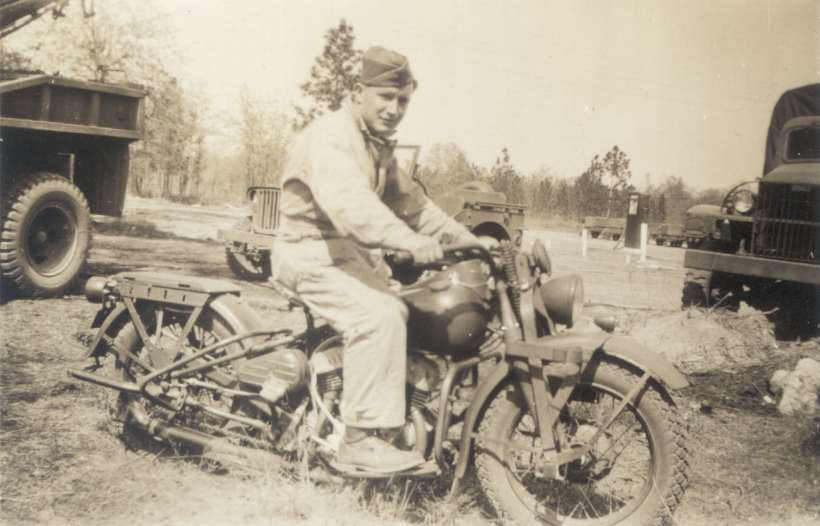 Photo from the Webmaster's Collection |
|
This GI
clad in HBT Coveralls sits on a 42WLA amidst other icons of WW2 US Army
transport. The
motorcycle seems to be a Type II or early Type III with Bicycle type kicker pedal and no
BO-Driving Light. |
'African-American
Rider'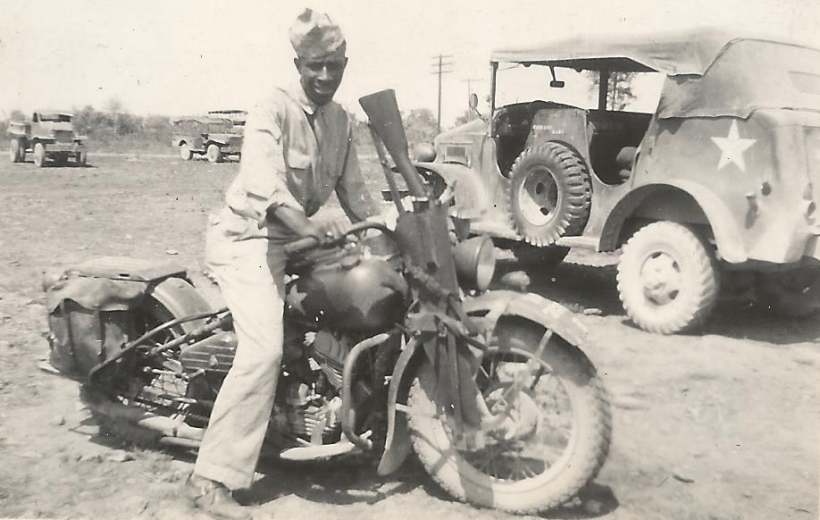 Photo from the Webmaster's Collection |
|
An African-American GI wearing the Summer cotton uniform poses on a WLA somewhere in the US during WW2. The
motorcycle is a standard Type III 42WLA. A M1903 Springfield Rifle is
carried in a M1938 Leather Scabbard. Dodge and Chevrolet trucks can be seen in the background. |
|
'Maison Blanche MP' Although the quality of the picture is rather poor, it does show some interesting details. The
picture was taken near Algeria's Maison Blanche (White house) airport
and shows a Military Policeman from the 1251st MP Company attached to
the 12th US Army Air Forces. The
bike is a Type II or early Type III without BO Driving Light but a
rather large pursuit light has been fitted next to the headlight. The rider wears the Summer cotton uniform with a very early British Dispatch Rider's Crash Helmet and goggles. This picture was taken by a GI from the 34th Division. |
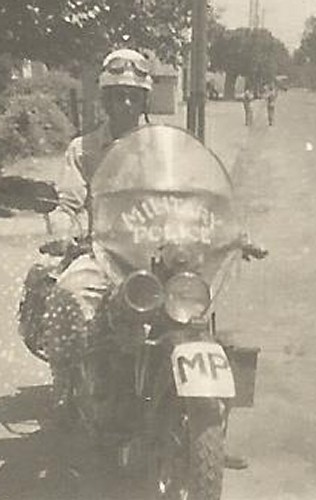 Photo from the Webmaster's Collection |
|
|
'Somewhere in North-Africa.....' Pfc Carson Jones
poses
for the camera astride a WLA in North Africa, He wears the standard M1941 wool uniform and wear of the helmet liner only suggests this photo was taken in a rest area. Note the brand new M10 Tank Destroyers on the left.
The motorcycle is a Type II 42WLA, evidenced by the bicycle type kick
starter pedal. |
|
'Old Ironsides' A T4 of
the 1st Armored Division 'Old Ironsides' poses on his ride, nicknamed
'Rosalie II'. The WLA is marked as the 5th vehicle of the 1st Armored Regiment's Reconnaissance Squadron of the 1st Armored Division (1/\1/\R5). At this point the 1AD was still a 'Heavy' Amored Division and would only change to a 'Light' AD on September 15th, 1943. The rider has attached a metal box to the rear fender and the rear lights have been lowered and rotated 90° in doing so. The US Army License Plate showing the USA number without a 'W' is clearly visible. The bicycle style kick starter pedal and parkerised circuit breaker cover are typical for an early to mid-production Type III. |
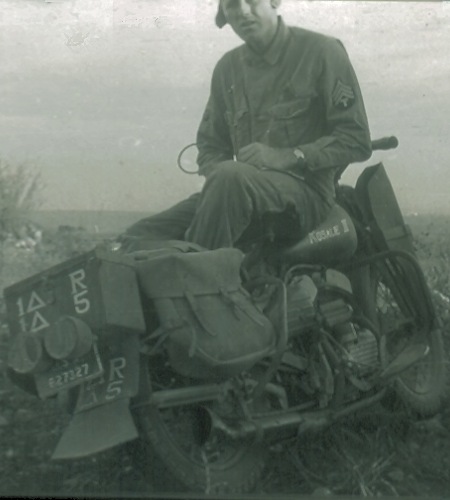 Photo from the Webmaster's Collection |
'Pacific
Outpost'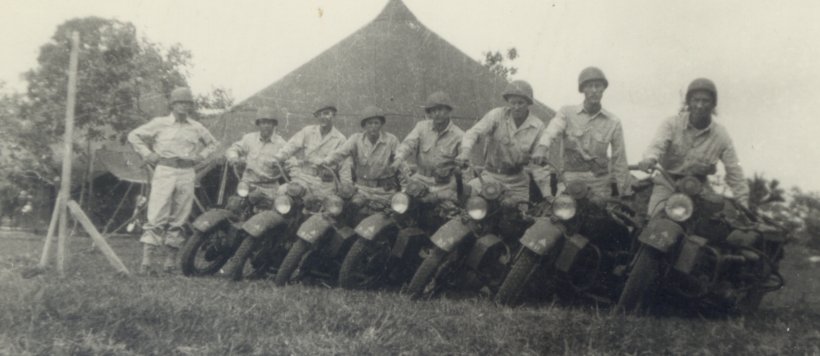 Photo from the Webmaster's Collection |
|
GIs line up
their rides for a group picture on Fiji during WW2. The WLAs seem
to be a mix of Types I, II and III; the fender markings remain a mystery. |
'French
Morocco'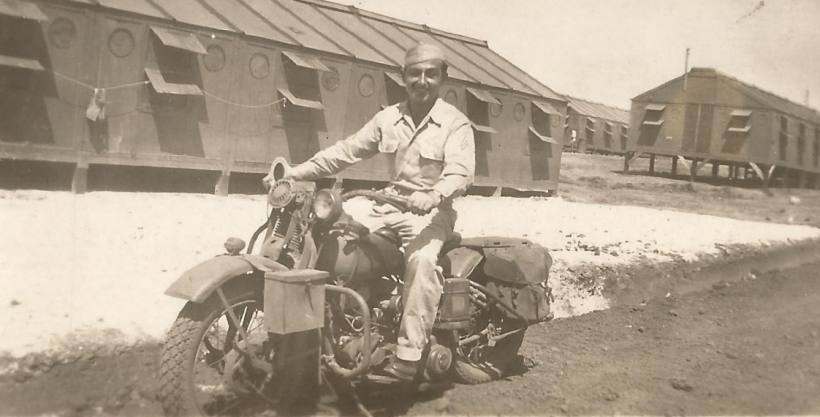 Photo from the Webmaster's Collection |
|
Wearing the Summer Cotton Uniform, a Corporal poses on a WLA in French Morocco
during WW2.
The bike is a Type III 42WLA which seems pretty new but nevertheless the
headlight and Black-Out Driving Light shroud are already missing. |
'Sloppy Riding...'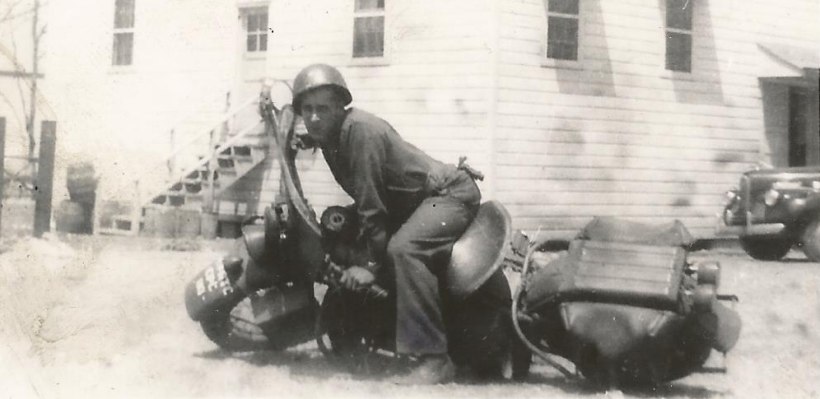 Photo from the Webmaster's Collection |
|
A GI
is caught on camera as he akwardly drops a motorcycle on its side at
Fort Knox, KY, early in 1943. The bike is marked for the Armored Forces Replacement Training Center (AFRTC) which trained soldiers in specific areas such as armor tactics, tank gunnery, communications, and maintenance. The GI is wearing the standard wool uniform in combination with the M1 Helmet Liner. |
|
'Tactical
Demonstration' |
|
The original caption of this often published picture taken in England in late February 1943 says 'An American dispatch rider with his motorcycle stuck in mud, firing his tommy gun while still in the saddle, during a tactical demonstration'.
The USA number (USA 620340)
painted on the tank clearly shows the bike to be a Type III. It is not yet
equipped with a Black out driving light which was introduced with USA W-624964. The rider wears the full Winter Combat Uniform with rubber Overshoes. The large bag on his left hip contains the early WW2 Service Gas Mask. The weapon is the M1928A1 Thompson Submachine Gun. |
|
'Over There...........' |
|
Pfc John W Gilbert, ASN17128615, poses on a WLA motorcycle in England ca 1943..... Gilbert wears the wool Service Uniform. The jacket is the early type with bi-swing back and belt hooks. He has the Army Service Forces insignia on the left shoulder and the Pfc stripe is just visible above the felt MP brassard. The leather Garrison Belt is worn with the Military Police shoulder strap and no doubt supports a .45Cal Pistol holster. Shoes are the Type II Service Shoe.
The motorcycle is a Type III 42WLA in what looks like brandnew condition. The
leatherette windshield is mounted very high and the headlight is blacked out. |
|
'Maintenance' |
|
GIs of a US Army Ordnance
Battalion overhaul WLAs of the 9th US Air Force in England in March 1944. Most
mechanics wear HBT coveralls and matching headgear. |
|
'Preparing Overlord......' |
|
May 1944, at dawn GI's from the 101st Airborne Division's Divisional Headquarters mount WLA motorcycles they have just unloaded from a British made Horsa Glider during a pre-Normandy Invasion exercise in England. Troopers all wear M1941 uniforms with Parachute Jump Boots. The rider in the foreground still retains his B4 Life Preserver.
Motorcycles are either Type III, IV or early Type V 42WLAs. The NCO on the left carries his
M1A1 Folding Stock Carbine in its canvas scabbard in the motorcycle's bracket. |
|
'Army
Air Forces Military Police'... |
|
A
Military Policeman from the US Army Air Forces patrols his post
somewhere in England during WW2. The
rider wears the standard wool Service Uniform of the era. |
|
'Rough Riders' |
|
Invasion
Training continues with Military Policemen riding on difficult terrain in
England on May 6th 1944. The markings on the bikes' front fenders have been censored on the original photograph, but the MP brassards worn by the riders identify them as such. Uniforms worn consist of wool riding breeches with high top Cavalry style boots, shirts and ties(!) and M1941 Field Jackets. The leather caps appear to be RAF Flying Helmets worn with American Optical Goggles. Side-arms are carried in leather holsters attached to the leather Garrison Belt and Shoulder Strap. Note the pistol lanyard worn by the rider in the center. A short movie was shot the same day, visible here: CLICK |
|
'Going My Way' S/Sgt Walsack takes a ride on an early Type III 42WLA, somewhere in the Continental USA during WW2. The bike is very basic without any accessories and devoid of markings. It is factory fitted with Firestone Sportsman tires. Sgt Walsack is wearing the Khaki Cotton Uniform issued for wear in warm climates. These were referred to as CKC (Cotton Khaki Clothing) in WW2 US Army slang. |
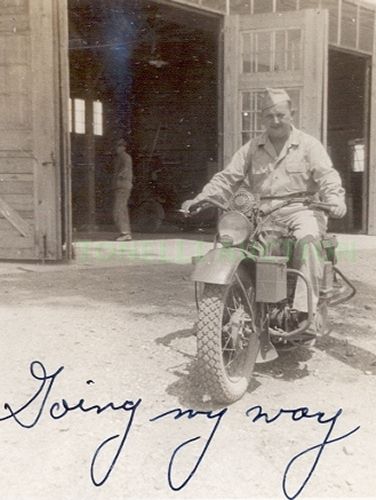 Photo from the Webmaster's Collection |
|
'Determined
Rider' |
|
This picture shows us a determined rider on what appears to be a Type IV 42WLA. The angle of the photograph gives a clear view on the tires and skid plate. It is not clear where or when the picture was taken and the markings are not clear either.... |
|
'Crossing the
Channel' |
|
Men and vehicles from the 3rd Armored Division are ferried across the English
Channel to Normandy, late June 1944. |
|
'SHAEF
Messengers' |
|
Lt Clawson, in charge of the SHAEF dispatch riders, gives them their final orders before sending them off to the coast to pick up the latest news from the boats coming back from the Normandy beaches in order to relay it to Headquarters following the June 6th 1944 landings. All but one
are American GI's wearing the wool Service Uniform and riding WLA motorcycles. All headlights have been removed and replaced by Black-Out Lights. No arms are carried. |
|
'ADSEC
MPs' |
|
The picture shows two Military Policemen about to ride out on their Harleys. It is not clear exactly when and where the photo was taken, but details on the picture suggest either England or France in 1944.
Bikes are marked 'MILITARY
POLICE' on the aprons and the front fender marking is 'ASCZ' over '984P' which
stands for 'Advanced Section Communications Zone ' and '984th MP Company'. Both riders wear British motorcycle rider helmets and British made wool US Army 'ETO' jackets. |
|
'Information
Point' |
|
This picture
taken by a British War Correspondent shows an Information Point from the British
XXXth Corps at the Railway Station of Bayeux, Normandy in early July 1944. The bike is a
Type III 42WLA with its front fender marked 3/\36-I over 2HQ-34. This
indicates the 34th vehicle of HQ 2nd Battalion, 36th Armored Infantry Regiment
of the 3rd Armored Division. The GI wears
the typical wool uniform of the period, with Polaroid All-Purpose goggles around
the neck. |
|
'Damn It, Use Signals!!' |
|
Private Roy Zimmerman of Wood River, Illinois, supervises US Army military
traffic near St Lo, Normandy, France on July 27th, 1944. Zimmerman was a
Military Policeman in the 507th Military Police Battalion, and wears the typical
uniform of the period. Note the leather gloves, American Optical sunglasses and
Tanker's Helmet with MP markings. In the background is a Jeep with a .50 Cal Machinegun, next to a Dodge WC-54 Ambulance. The 'DAMN IT USE SIGNALS' sign seems to be made out of carton and is hung up by a piece of string. A US Army censor has prepared the photo for censoring with a red pen....... |
|
'Maintenance' |
|
Liberator-Riders of the 2nd Armored Division perform basic
maintenance on their bikes in a French field in the Summer of 1944. These GI's
sport a variety of uniforms and equipment: HBT one-piece suit on the left,
winter combat jackets (aka Tanker Jackets) on the guys in the middle and wool od
shirt on the right. Note the variety of headgear and goggles: Polaroid All
Purpose, American Optical and Resistal M1938 types..... The trooper working on
the left bike carries a M1918 Trench Knife in a leather scabbard. |
|
'Preparing
for Evening Colors' |
|
In Oran, Algeria, American
Troops march through the streets in preparation for Evening Colors. The
date of the picture is not clear and the M1944 Goggles worn by the rider
suggest the picture was taken late in WW2, unless the Goggles are the
USAAF B8 style which were issued earlier. The
high Ammo Box and lack of BO Drive light could indicate a Type II bike
or early Type III. |
|
|
'Services of Supply' A Captain of the US Army's Services of Supply (SoS) rides a WLA on an English country road in the spring of 1944. Looking at the front fender and low Ammo Box, the bike is either a Type IV or early Type V and it is equipped with both Windshield and Legshields. Markings are rather
limited with the US Army 5-pointed star on the front fender and the unit
stencilled on the leatherette windshield apron. SOS stands for Services of
Supply and sadly the details of the subunit cannot be read because of the
reflection. The Officer's clothing
is the standard US Army wool set of the period, commonly known as the
M1941 uniform. The Services of Supply was renamed Army Service Forces in 1943. |
|
|
'Me and my WLA........' An unidentified Sgt poses next to a WLA from a Military Police unit. The bike is a another Type IV or early Type V, identified by the low Ammo Box and first pattern front fender. A red light has been mounted on the front fork next to the horn. The legshield bracket is barely visible between the Ammo Box and the front crashbar. The windshield seems to be leatherette, which indicates the bike is 42WLA42000 or lower..... Markings
consist of the MP marking on the windshield and stars on front fender and
tanks. The other marking on the fender is illisible, as is the marking on
the windshield above 'Military police'..... The painted headlight and the right-hand side mounted rear view mirror suggest this photo was taken in Great-Britain in 1944....... |
'Special Service Engineers'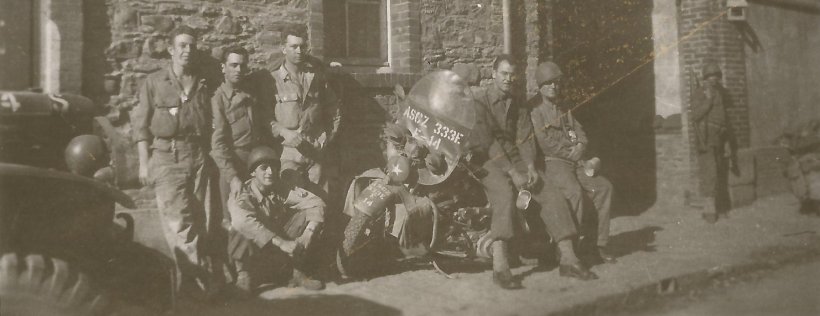 Photo from the Webmaster's Collection |
|
GIs take a break somewhere in France in 1944. There are two WLAs visible in the picture.
The Type IV 42WLA in the
center, fitted with dual Black-Out Driving Lights and 'Cavalry' style
saddlebags slung over the front fender, is marked ASCZ 333E E-14 on both
leatherette windshield apron and front fender. The markings indicate
vehicle 14 of Company E, 333rd Engineer Special Service Regiment
attached to the Advance Section Communications Zone (ASCZ).
The 333rd Engineer S.S.
Regiment's mission was to
construct and improve
overseas installations such as docks and port facilities, railroads,
roads, plants, etc.
The men around the Harley
wear a mixture of wool and Herringbone Twill (HBT) uniforms. |
|
'Summer Patrol' A Military Policeman patrols Fort Riley, Kansas in 1944. The bike looks fairly new and is a Type I 42WLA with high headlight and bicycle style kickstarter. The Solo Windshield is mounted in its highest position on the handlebars with the leatherette apron strap fastened between the front forks and horn bracket. The US Army Number Plate is clearly visible attached to the rear light support. The
soldier is wearing the Summer Cotton Uniform with Service Shoes. |
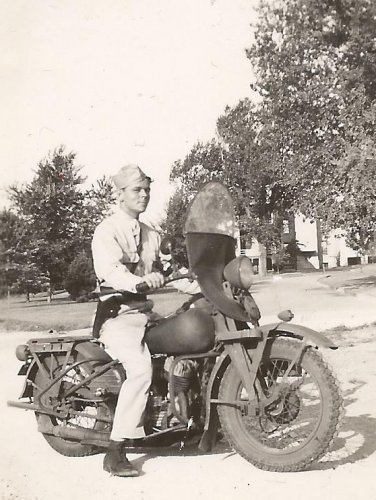 Photo from the Webmaster's Collection |
'Dashing
thru France'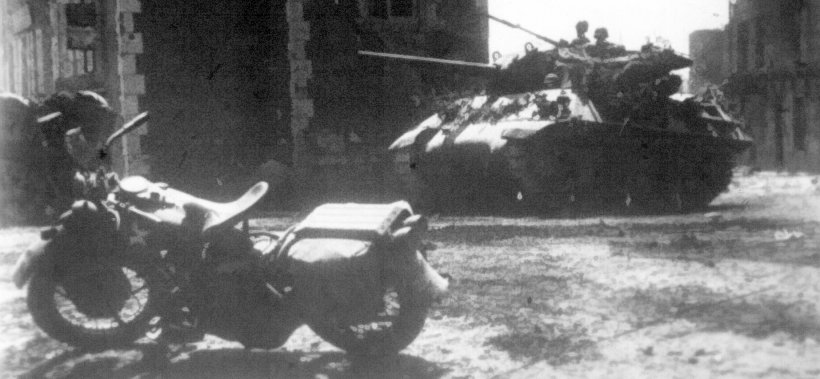 US Army Signal Corps Photo / Webmaster's Collection |
|
Following the successful break-out in Normandy, a Tank Destroyer speeds around a corner and past a parked WLA in Percy, France on August 1st 1944. The bike is either a Type IV or early Type V 42WLA and close scrutiny of the fender markings on the original print show it belongs to the MP Platoon of the 28th 'Keystone' Infantry Division (28-X P-? ). The 28th Division was made of units of the Pennsylvania Army National Guard and is the oldest division-sized unit in the US Armed Forces... |
|
'Yanks and a Limey in
France' |
|
At Pacy-Sur-Eure, France, American and British troops meet
on August 27th, 1944. US Army Officers discuss the situation on the pavement
while Cpl Gordon C Powell of the 82nd Armored Reconnaissance Battalion poses
next to British XXX Corps Dispatch Rider Baltins Dogoughs. Dogoughs rides a
Norton 16H with missing front fender and has picked up a German MP40
Submachinegun along the way. He wears standard infantry trousers, shoes and
helmet instead of the special motorcyclist's gear. |
|
'What
are the odds???'.... |
|
About 2 weeks after Cpl Powell
was photographed in Pacy, France alongside a British Despatch Rider; he is
welcomed by Dutch civilians. Powell
has discarded the camouflage suit and now wears standard wool garb. What are the odds of seeing the same GI on the same bike in two different places on pictures from different sources?? |
|
'Preparing
for War'... |
|
A group of unidentified GI's pose for a photo during training in Louisiana in 1944.
The
bike is a standard Type III 42WLA with a Thompson Sub Machinegun carried
in the scabbard on the front forks, together with a map of the area. |
|
'Army
Air Forces Military Police' |
|
Two
Military Police WLAs stand side by side somewhere in England during WW2. The markings 8* 1192 MP indentify the unit as the 1192nd MP Company (Aviation), attached to the 8th Air Force in Britain. This Company policed air stations in different parts of England such as Elveden Hall, Boxted and others. Note the difference in Military Police markings on both windshields. |
|
|
'Top Kick In the ETO.....' Somewhere in the European Theater of Operations, a Company First Sergeant poses on the unit's Harley....
The bike appears to be a Type IV or early Type V 42WLA with low Ammo Box and first
pattern front fender.... The NCO wears the typical WW2 wool uniform, with his 1Sgt rank insignia barely visible on his shirt sleeves… |
|
'Army Air Forces in England' |
|
A Corporal of the US Army Air Forces poses on a Type III 42WLA in use at a USAAF Airfield in England during WW2.
The bike's in front of a 'Nissen' Hut, typical for the US Airfields in Britain
in WW2. The sign on the wall says: 'Reserved Commanding Officer' and a bicycle
rests against the right side of the building. |
|
'Patrolling the Airfield' An unidentified Military Policeman patrols the American Airfield at North Pickenham, England during WW2. The WLA
is a Type IV or early Type V 42WLA with low Ammo Box and first pattern front fender. The
headlights lens has been painted OD. The
rider wears the Winter Service Uniform of wool trousers and jacket with
leather and wool gloves. |
|
|
'Somewhere in the
ETO' |
|
The two images above show two GI's posing on a WLA motorcycle, somewhere in the
ETO. The bike has some interesting features. The painted engine crankcase, low
ammo box and first pattern front fender all identify it
as a Type IV 42WLA. |
|
'Courier' Corporal Weaver poses on his motorcycle somewhere in Europe during WW2. Although the picture is rather grainy the bike is clearly a Type IV or early Type V, identified by the low Ammo Box and first pattern front fender. Of special interest is the marking 'COURIER' on the windshield apron leaving no doubt as to the rider's mission. The rider's name and
rank have been stencilled on the upper part of the windshield. The rank
T/5 refers to Technician 5th Grade, which was an equivalent pay grade to
a Corporal, but without the authority of the latter. |
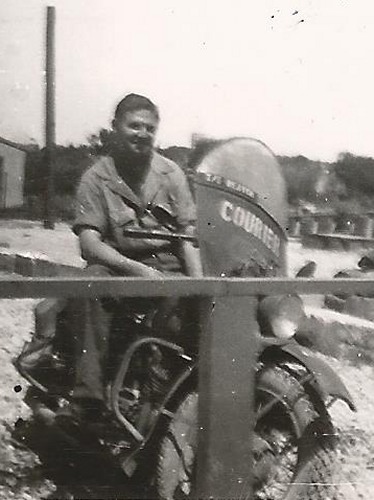 Photo from the Webmaster's Collection |
'Dusty Riders'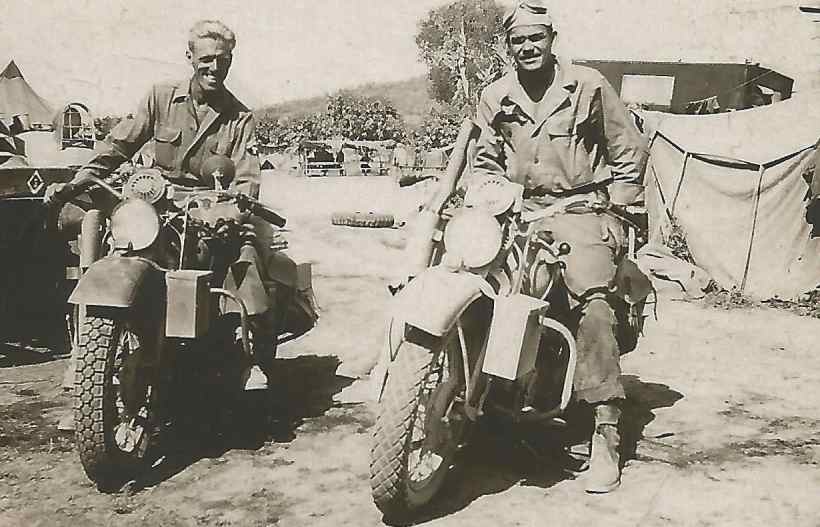 Photo from the Webmaster's Collection |
|
Two
GIs sit on their dusty WLAs in July 1944. The bikes are most likely Type
III. Note the different tires; Firestone ANS on the left and Good Year MC Sport Special on the right. A Half-Track can be seen on the left. |
|
'Hot Summer Sun' Sgt
Larry Nolan poses on his ride under a hot Summer sun. The location of the
photograph is not known but the vegetation and rocky surface would suggest
this photo was taken somewhere in the ETO. The photo was taken by a member
of the 34th Armored Battalion of the 5th Armored Division. This Division
went all thru France in the Summer of 1944. The
bike is most probably a Type IV or early Type V; the low ammo box is just visible between
the first pattern front fender and front tire. Markings on the front
fender are not quite clear but the top number is a '3' with '918??'
underneath. |
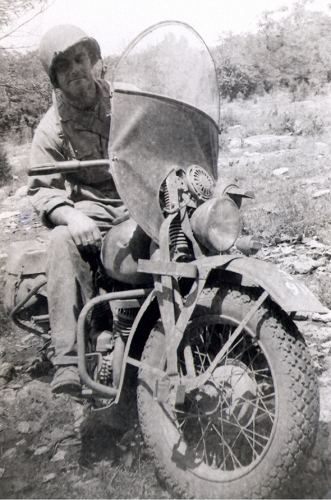 Photo from the Webmaster's Collection |
|
'Chalons-Sur-Marne, 1944....' |
|
US Army vehicles pass through a devastated Chalons-Sur-Marne. The French city,
located just South-East of Reims, was liberated in late August 1944. The
markings 3A-44?? on the trailer's left fender indicate a unit attached to the
3rd US-Army under General Patton. |
'Stars Galore'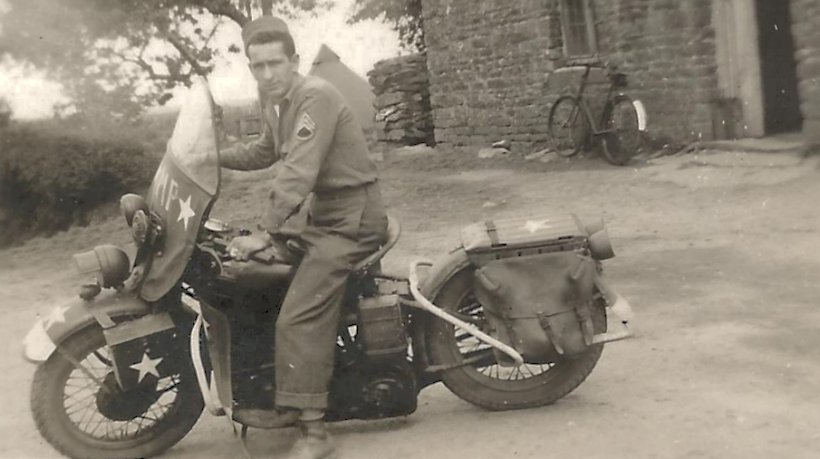 Photo from the Webmaster's Collection |
|
A GI from the 9th US Army Air Force poses on a WLA, somewhere in Europe during WW2. The
bike is a Type III with high Ammo Box. The headlight has been replaced
with a Black Out Model which, in combination with the white painted
fender tips and crash bars are an indication of use in England where
black out conditions were common during the war. An extra light is
mounted on the right of front forks. The Staff Sergeant is wearing the typical wool uniform of the era. The
9th AAF moved to mainland Europe once airfields had been established on
the continent after the Normandy invasion and seeing the style of house
and tent in the background, this picture was most likely taken in
France. |
|
|
'Company First Sergeant....' The scenery in the background being typical for the French or Belgian countryside, this picture was probably taken in Northern France or Belgium around August/September 1944.
The bike is a Type II 42WLA with bicycle style kick starter and no Black
Out Driving light..... Although the markings
are not clear, they show the bike probably belonged to Co A/817th Tank
Destroyer Battalion, attached to the 3rd US Army at the end of August 1944 The NCO wears the standard WW2 wool uniform, with paratrooper jump boots... A local boy stands in the background, in front of what could be the local cemetery. |
'Tent
City...'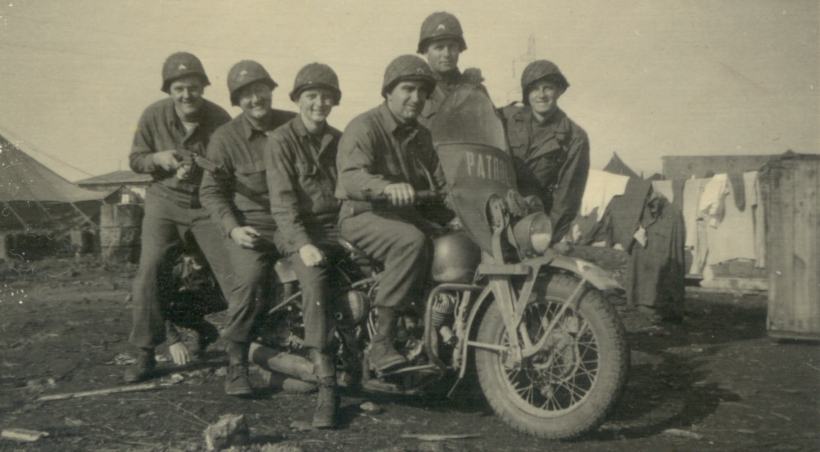 Photo from the Webmaster's Collection |
|
A total of seven (Yes, 7!) GIs have
gathered on and around this bike in a tent camp somewhere in the ETO in
1944/1945. All
men wear standard wool uniforms with so called 'Double Buckle' Combat
Boots which did away with the cumbersome leggins from late 1944 onwards.
The helmet nets with larger squares were typical of the 79th Infantry
Division in Europe, but it is not clear if these men belonged to that
unit. |
|
'Going Downhill' Motorcyclists of the 89th Infantry Division practise riding down steep slopes at Fort Carson, Colorado in 1944. The
leading bike shows some early features such as the bicycle style kick
starter pedal, high Ammo Box and absence of BO Driving Light. Both
riders wear the one-piece HBT suits with leggins and service shoes.
Headgear consists of the Tanker's Winter Combat Helmet and M1938 Resistal
Goggles. The 89th Infantry Division was the first major unit to be activated at Fort Carson during WW2 and was shipped to Europe in early 1945 where it saw combat during the last months of the war. |
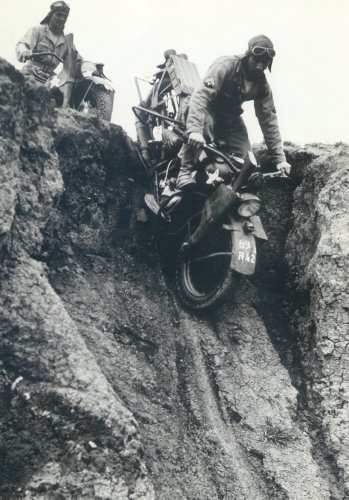 US Army Signal Corps Photo Webmaster's Collection |
|
|
'Check Tire Pressure
Daily!...' Two Sgts from a 9th US Army Air Force Support Unit check the tire pressure of their WLAs, somewhere in Europe during WW2. The
issue tire pressure gage usually made by Schrader used here is the
standard long type issued with most WW2 vehicles. Late WLA toolbags came
with a short model gage. Both
NCOs are wearing standard uniforms of the period, od Field Jacket on the
left and a British Made ETO Jacket on the right. These British Made
jackets were not uncommon within the 9th AAF field troops in the ETO. |
|
'9th US Army Air Force...' Once
parts of France had been liberated following the Normandy invasion, units
of the 9th USAAF moved to the continent to fly missions from often
makeshift airfields. This
Type IV or early Type V 42WLA is marked to the 40th Support Command of the
9th US Air Force (9*40th S.C.).
|
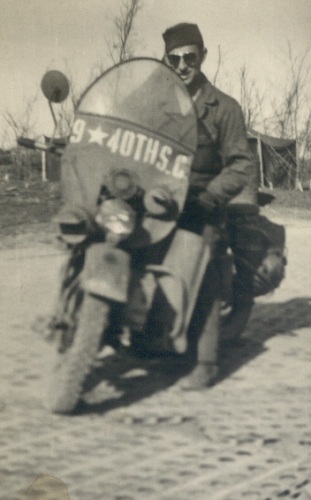 Photo from the Webmaster's Collection |
|
'Aachen, Fall 1944...' A WLA
rider stands next to his ride as other GI's pose for the camera with the
bike. An M1938 Dispatch Case is slung from the leather gun scabbard on what appears to be a Type III 42WLA. The rider is clad in typical winter garb for Armored crews, including the much coveted Tanker's Jacket and matching bib trousers, along with assorted headgear and M1938 Resistal Goggles. A hastily camouflaged Half Track is parked in the background. |
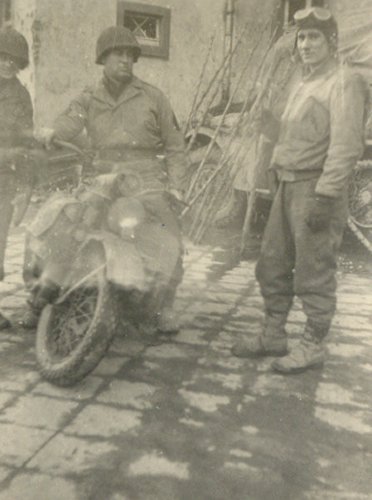 Photo from the Webmaster's Collection |
'Armored Advance'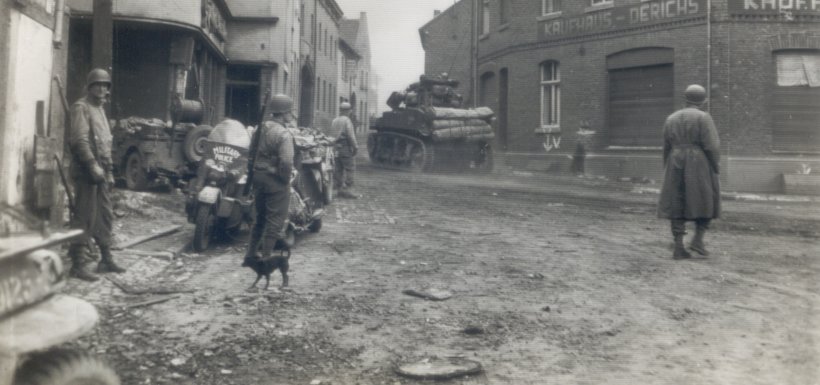 Photo from the Webmaster's Collection |
|
An Armored unit advances through Palenburg, Germany in October 1944. The Low Ammo Box on the motorcycle on the left is clearly visible. The bike is equipped with both Legshields and Windshield, the latter bearing rather unusual Military Police markings. The two men in the middle of the street might be the MPs overlooking traffic... Even at this late stage of the war, the GIs are still wearing the M1941 Wool Uniform although some have already received the new Combat Boots (aka Double Buckles). An DR-5 Wire Reel has been fitted to the rear body panel of the Jeep on the left. Succes of Army Operations depended heavily on communication which led to thousands of miles of wire being laid near the front. |
'Cannon Company...'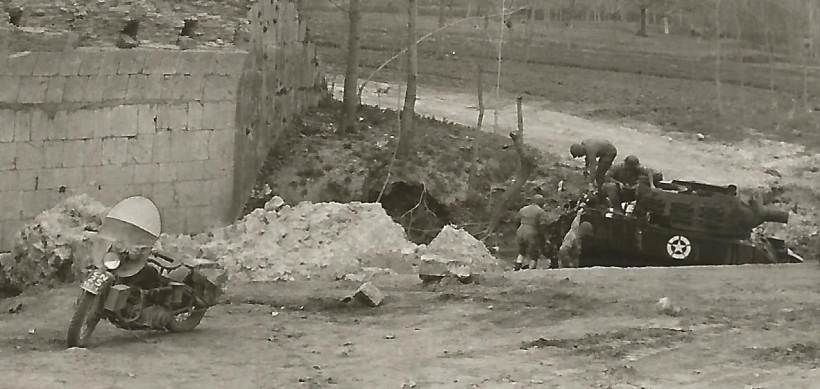 Photo from the Webmaster's Collection |
|
A Type IV or early Type V 42WLA is parked near the firing position of a 75mm M8 Howitzer Motor Carriage (HMC) somewhere in Europe during WW2. The bike is equipped with a Low Ammo Box and a standard Windshield with the rubber strip around the edge of the plexi top. The fender marking CN over 25 indicates the 25th vehicle of an Infantry Regiment's Cannon Company although officially those companies were not issued motorcycles. The other markings are not clear and thus the unit of the WLA remains a mystery. M8 HMCs were typically found in units of Armored Divisions. |
|
'Adjusting
the Front Brake' |
|
The photo above showing superb detail was taken on November 6th, 1944 by J.A.
Demarco, Det E of the 165th Photo Signal Company attached to the US 1st Army in
France.
Although the bike is covered in
mud and dust, there are some great details to be seen. |
|
|
'Dutch-German Border Region' Pvt James F Hammons, a Military Policeman from the 29th MP Platoon, 29th
Division, is about to ride off on his WLA in November 1944..... |
'Putting on my Top Hat'...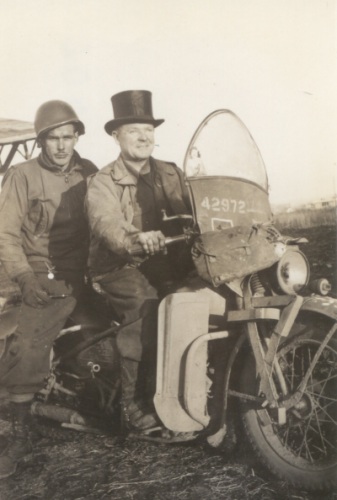
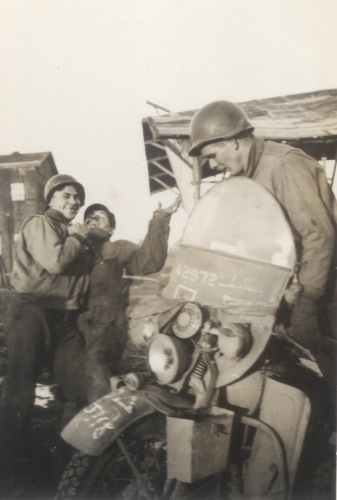 Photos from the Webmaster's Collection |
|
GIs from the 3rd Armored 'Spearhead' Division are clowning for the camera with a Top Hat and a WLA somewhere in Belgium in the winter of 1944-1945.
The
Type III 42WLA shows signs of extensive war use, notably to the
headlight and Ammo Box. A Lightweight Gas Mask bag is slung around the windshield... |
'Muddy
Germany'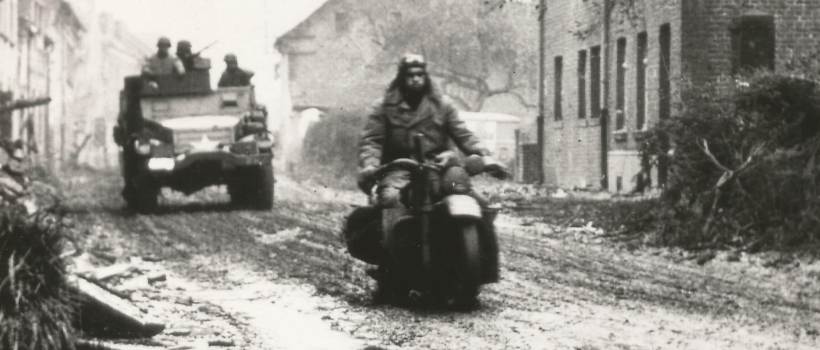 Photo from the Webmaster's Collection |
|
A WLA rider leads fellow GIs in a Halftrack through the German village of Beggendorf near Aachen in November 1944. The road conditions are typical for those encountered by American troops in the ETO in the fall of 1944 and even with its low road clearance the WLA manages the mud quite well. The motorcycle rider is clad in winter clothing composed of a 3rd pattern Mackinaw coat with Winter Combat Helmet and Goggles. The legshield equipped Harley is fully loaded with bulky saddlebags and Thompson SMG in its leather scabbard. |
|
'Battle
of the Bulge'... |
|
Two
Military Policemen of the 5th Armored Division take a short break along
a cobblestone road. Both WLAs are standard and the markings of the 5th Armored Division's Headquarters are visible on the rear fender of the bike in the foreground. Stars and nicknames have been painted on the tanks. |
|
|
'Belgian Winter...' A rider of the 23rd Armored Engineer Battalion attached to the 3rd Armored Division poses with his bike in snowy Belgium early in 1945. The motorcycle is a Type IV or early Type V 42WLA with low Ammo Box and first pattern front fender. Oddly the Black Out Drive light and its bracket are missing from the front forks. This GI still wears the early WW2 wool uniform with OD Field Jacket (aka M1941) with the cloth Winter Combat Helmet adorned with Airway type goggles. Although difficult to make out, his shoes seem to be cloth Overshoes. No
extra gear is carried on the bike although the luggage rack is fitted with
two straps. |
|
'Atrocious Weather' The winter of 1944-45 was one of the worst and coldest in history, yet it didn't stop the WLA riding GI! This
picture was taken in Europe that winter. The uniform worn by the rider is barely different from the one he wore coming ashore in France the previous Summer and one can only imagine how miserable conditions must have been for the soldiers at the front. |
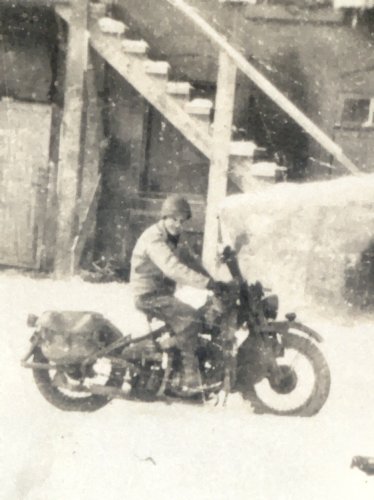 Photo from the Webmaster's Collection |
|
|
'Snow.....' Posing on a 42WLA during winter 1944-1945 near the Belgian/German border is Guy Shoaf who participated in all campaigns of the ETO as a member of the 2nd Ranger Battalion. With Company F he was one of the first men to reach the top of the Pointe du Hoc on D-Day. The bike is a bit of
an oddity. It has the headlight in the high position as on a Type I 42WLA,
but the makeshift headlight bracket and (German?) horn suggest the light
was moved upwards by the unit mechanics. Markings are limited to 2RNGR, indicating a vehicle of the 2nd Ranger Battalion. Ranger Battalions were issued 6 motorcycles for messenger duty during WW2. Shoaf wear winter garb with a Tanker's Jacket and either has paratrooper boots or overshoes. He seems to be holding a Thompson Submachine Gun. |
|
'Slippery Riding.....' A messenger takes on a muddy road in a
German forrest in early 1945. |
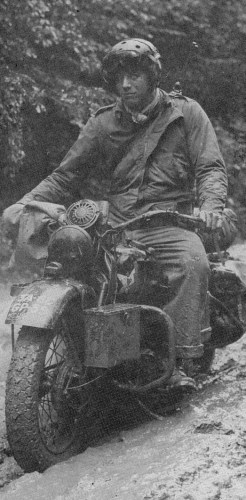 US Army Signal Corps Photo via Alain Batens |
'USAAF
Advanced Landing Ground'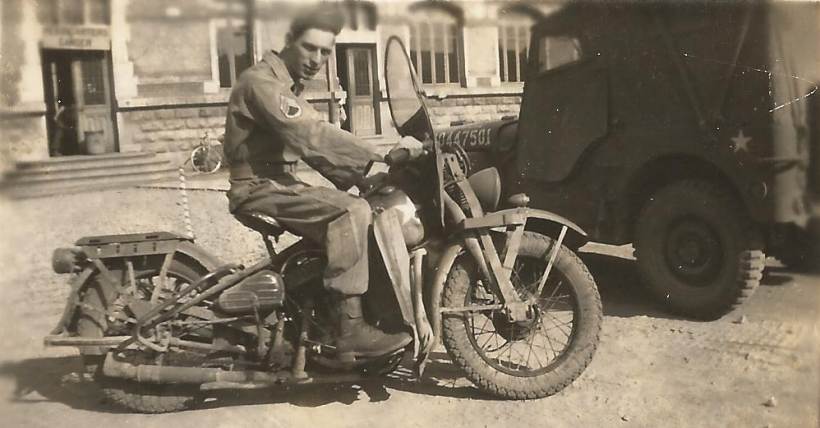 Photo from the Webmaster's Collection |
|
A Staff Sergeant poses on a
standard Type III 42WLA equipped with both Windshield and Legshields in front of
a Headquarters building in Giraumont, France in March 1945. The rider is wearing a one-piece Herringbone Twill (HBT) Suit with double-buckle combat boots and the USAAF Type A-3 Mechanic's Cap confirms his Air Force branch.
The Jeep in the background is
fitted with improvised doors and fully enclosed top. |
'Brothers in
Arms'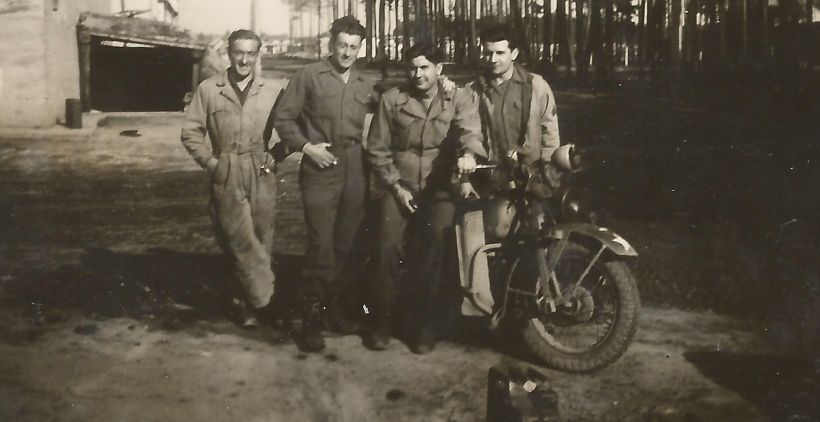 Photo from the Webmaster's Collection |
|
Four GIs from the 460th Anti-Aircraft-Artillery (AAA) Automatic Weapons Battalion have their picture taken with a WLA near Naumburg, Germany in April 1945. The motorcycle bears signs of use with a broken headlight and added lamp on the handlebars. The metal strap on the legshields has been repositioned and fixed around the front crashbars for extra support. A rather large star has been painted on the front fender. The marking above the star remains unclear. A British Jerrycan fitted with a red 80 Octane tag can be seen in the foreground. |
|
'Exploring
the Italian countryside....' |
|
An
Officer and a Technical Sergeant have both taken a WLA for a spin around
the Italian Countryside during the later part of the war in Europe. Since
the men don't have any insignia and the bikes' fenders are not marked,
the unit remains unclear. |
|
|
'The Chief...' Lieutenant Halsey S HAYS stands between two WLAs, somewhere in Europe in 1944. Both bikes have white
markings on the front fender and one bike has had its windshield apron
painted white and marked 'POLICE' and 'CHIEF', referring perhaps to this
Officer. Lt HAYS wears a leather Air Force Type A-2 Flying Jacket in combination with tan (pink) trousers and Parachute Jump Boots. |
|
'La
Bella Italia....' |
|
Both WLAs shown above are marked to HQ, 10 Port Battalion attached to the Peninsular Base Section (PBS). The PBS was a large organisation which controlled the ports of Naples and Leghorn (Livorno) and the rest of occupied Italy during the later stage of WW2. Both windshields and fenders have been painted white for better visiblity. The bike on the left with first pattern front fender is either a Type II or III. The WLA on the right has the second pattern fornt fender with high Ammo Box which indicates parts have been mixed. Both GI's probably belong to the Maintenance & Repair Section (M&R) of the above mentioned unit and their bikes provided a rapid means of transport from one place to another. They both wear light HBT uniforms. |
|
'Good Ole Sarge...' This picture is actually a postcard printed in France and sent home by this Technical Sergeant during WW2.
The motorcycle seems to be an early Type III 42WLA identified by the
rectangular air filter and the absence of a Black Out Driving Light on the
front forks. But then again the headlight is missing too.... Looking
at the age of the GI on the bike, he most probably belongs to a support
unit behind the front line and his rather casual uniform seems to confirm
this. |
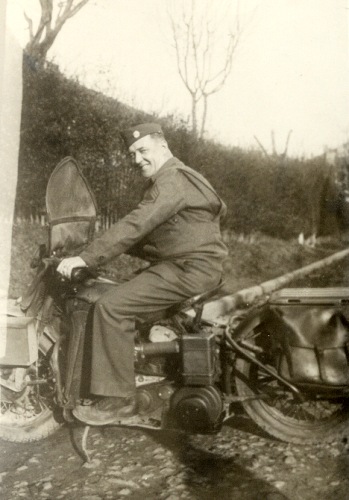 Photo from the Webmaster's Collection |
|
'Motorpool
Harley' |
|
This WLA without Ammo Box and
Scabbard Carrier has a slightly damaged front fender. |
|
'CBI Theater of Operations' The use of the WLA was not restricted to the European Theater of Operations as shown by this T5 wearing a CBI Theater (China-Burma-India) Patch on his Summer uniform shirt. The
motorcycle is a straight from the line early Type V with first pattern
front fender and steel carburetor inlet tube. Place and date of this picture and the identity of the rider remain unknown. |
|
'Parts Bike'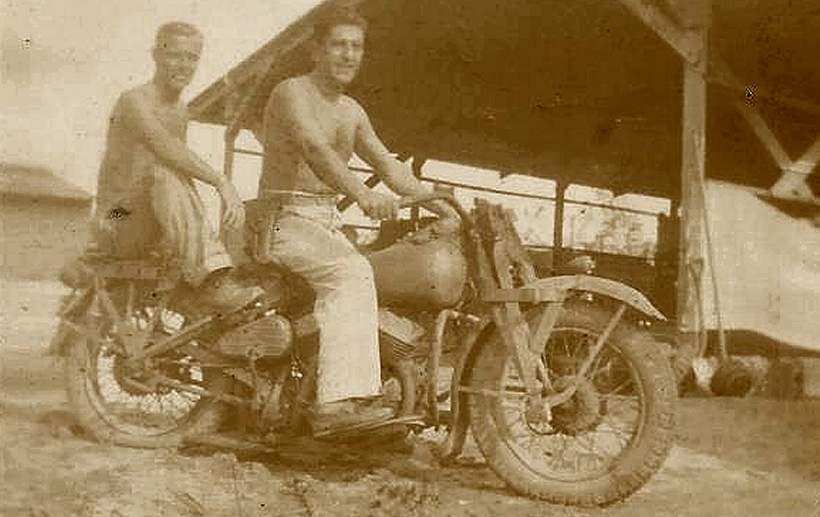 Photo from the Webmaster's Collection |
|
Two
unidentified GIs sit on a Type II 42WLA which has obviously seen a lot
of action and is now used as a source of parts for other motorcycles. Uniforms are limited to Summer Cotton Trousers, and with the war still going on, a M1911A1 Pistol is carried in a leather holster. |
|
'After the Bulge...' A T4 of
the 67th Medical Group has his picture taken in Hastière, Belgium, in
February 1945. The WLA
is marked as the 8th vehicle of the 67th Medical Group attached to the
15th Army ( 15A67MGP-8 ). The
bike is a Type III 42WLA equipped with makeshift legshields, based on the
standard design. |
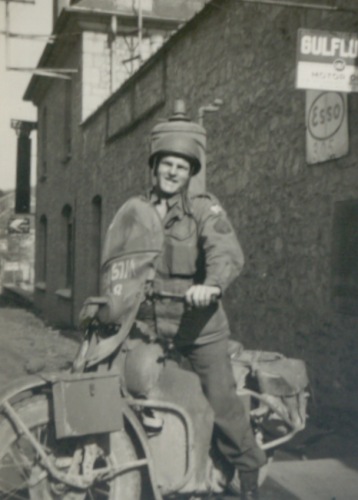 Photo from the Webmaster's Collection |
|
'Tank
Transporter'... |
|
The
crew of an M26 Heavy Tractor stand in front of their rig somewhere in
the ETO in winter 44-45 The unit has its own motorcycle escort on a Type IV or early Type V 42WLA and the bike's windshield is clearly marked 'TANK TRANSPORTER' leaving no doubt as to the rider's mission. Even at this later stage of the war, all crewmembers still wear early style jackets (M1941, Tanker's or Mackinaws) although M1943 Field Jackets started to replace all of these by mid 1944. |
|
|
'Italian Mud...' A Military Policeman sits on his Harley-Davidson somewhere in Italy in 1944/45. Although the exact MP unit is not clear, this WLA sports markings that
are typical for a motorcycle of the 202nd Military Police Company
attached to the US 5th Army's Second Corps. The rider wears paratrooper style boots with HBT Trousers and an OD Field Jacket. The 202nd MP Company was activated at Camp Blanding, FL in May 1942 and saw action in North Africa, Sicily and Italy during WW2. |
|
'Cobblestone Ride' An American soldier is about to mount a WLA during the war.
Looking at the low Ammo Box and first pattern Front Fender the bike is a
Type IV or early Type V 42WLA. The GI is wearing standard wool trousers with the Winter Combat Jacket, favored by Armored crews. Only the helmet liner is worn as headgear. The house and cobblestone street are typical for the old European towns. |
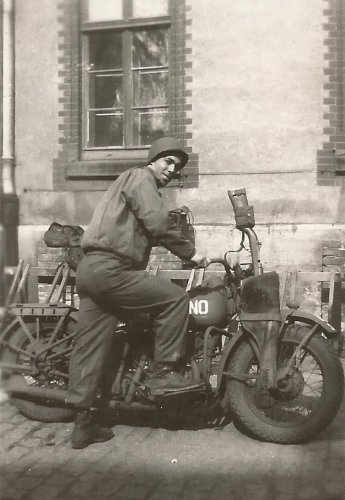 Photo from the Webmaster's Collection |
|
|
'Germany, 1945' A Ranger of the 2nd Battalion rides his Type III
42WLA thru pre-war built German Army barracks in the spring of 1945. Contrary to the 2nd
Rangers' bike shown above, this one is marked to the 2nd Ranger Battalion attached to 12th Army Group
(12AGP 2-RNGR), again with no specific subunit specified. |
'7th
Army Rider'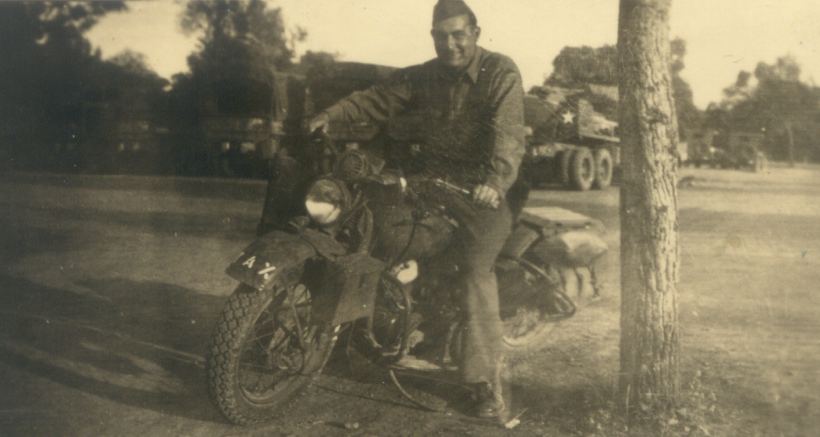 Photo from the Webmaster's Collection |
|
The
above picture shows a GI on a standard Type III 42WLA during WW2. The uniform of the rider is the standard wool uniform of the era, worn without leggins or other equipment. In the background are other vehicles of the unit with a rather uncommon 2 1/2 Ton Gasoline Truck on the right. |
|
'Harleys and
Scout Cars' |
|
This is
actually a cropped postcard showing a Military Police unit with 14 WLAs and
Scout Cars. |
|
'The end is near...' Near the end of the war in Europe, a Military Policeman of the 804th MP Company attached to the US VIIth Corps sits on his Type III 42WLA in Germany in the spring sun of early 1945. The insignia of the VIIth Corps is painted on both helmet and windshield apron. The fender markings are VII-X above 804P-8 indicating the 8th vehicle of the Company. Other parts of the bike have been highlighted in white and skirts have been added to the front fender. Legshields are attached to the frame. The rider wears the Arctic Field Jacket, even at this late stage of the war. He holds a pair of sunglasses in his hands. A rifle or Carbine, protected by a canvas cover, is kept in the leather scabbard. The picture was taken along the river Rhine between Bonn and Remagen as indicated by the roadsign indicating the river ferry at Rolandseck (Fähre Rolandseck). |
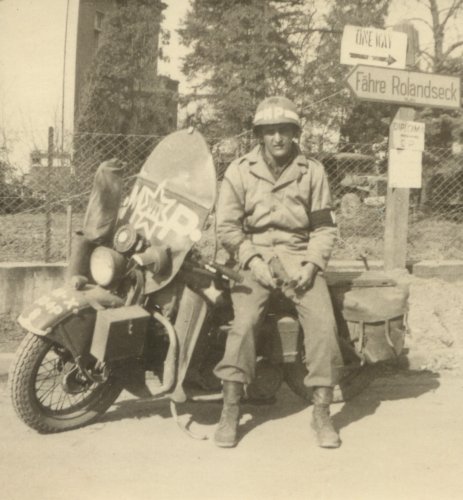 Photo from the Webmaster's Collection |
|
|
'Sightseeing in Italy...' Somewhere in Italy a GI is taking pictures. A Type IV 42WLA has
been parked on the side of the road and the varied and striking markings
lead us to believe this picture was taken after the end of hostilities. |
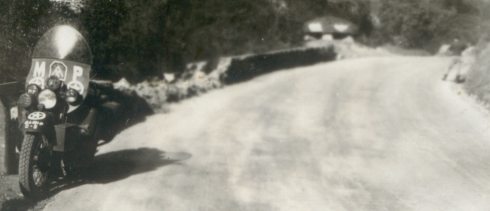 Photo from the Webmaster's Collection |
'389th Military Police Battalion'...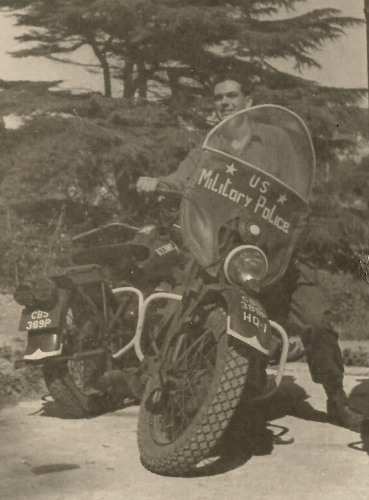
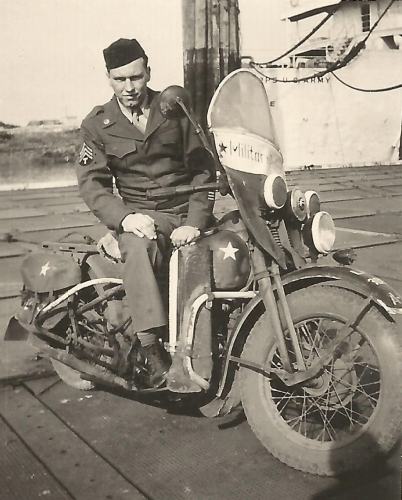 Photos from the Webmaster's Collection |
|
The three
WLAs shown above are all marked 389P which indicates the 389th Military Police
Battalion. The GI posing on the WLA on the right wears the typical late WW2 wool uniform with the popular 'IKE' jacket. |
'Coming Home'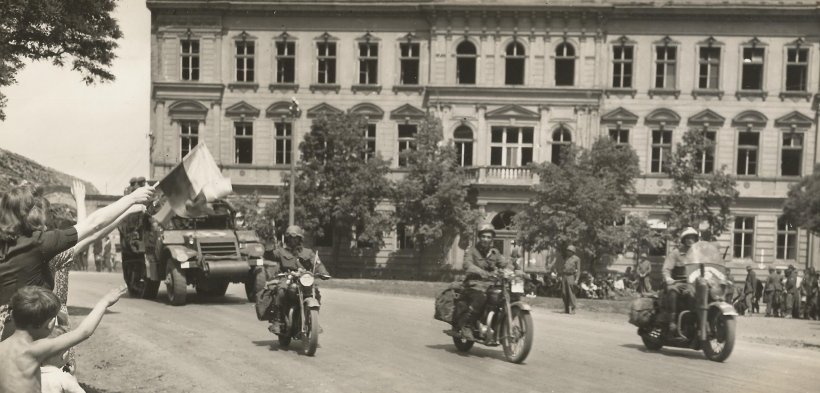 Photo from the Webmaster's Collection |
|
An American motorcycle MP guides the Czechoslovakian Armored Brigade through Pilsen on 18th May 1945. The Czech Brigade had broken the siege of Dunkirk, France shortly before and was welcomed home by a flag waving crowd. The Czech soldiers are escorted through the city by a WLA-riding MP from the US Army's 2nd 'Indian Head' Division which had advanced towards Pilsen earlier and Divisional MPs can be seen guarding German prisoners on the right. The Czech Brigade was equipped with British (Lend-Lease) uniforms and equipment and two British motorcycles and International M5/M9 Half Track can be seen next to the US Harley-Davidson. |
|
'Two
WW2 US Army Icons'... |
|
The bike shown above next to a
Ford GPW Jeep seems a Type II with Bicycle Style starter pedal and This picture showing two WW2 Vehicle Icons was taken outside the Motorpool Office at Camp Swift, Texas in 1945. Note the female driver at the wheel of the Jeep. The CS marking on the Jeep's bumper indicates Camp Swift while the PMP-35 marking remains a mystery. GIs wear khaki Summer uniforms. |
'Parachute Infantry Patrolmen'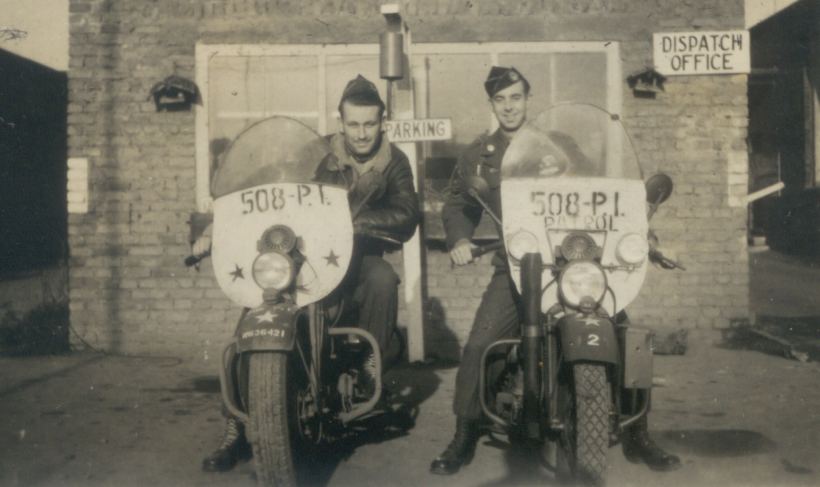 Photo from the Webmaster's Collection |
|
Two paratroopers of the 508th Parachute Infantry Regiment pose on WLAs after the end of the war in Europe. During the early occupation period many units were assigned to patrol and police various areas of Germany. The
windshields of both bikes have been painted white and marked to the unit
(508P.I.) with the same marking repeated on the front fender of the WLA
on the left. Both riders wear Garrison Caps with parachute badges and Jump Boots. The rider on the right wears an IKE jacket with full awards and insignia while the one on the left has donned a B-6 Type Air Force Jacket. |
|
'9th US Army Motorcycle' An American GI poses on a WLA motorcycle near the end of the war in Europe. The bike shows
considerable wear to the front fender and accessories. Although still
attached to the front forks the machinegun bracket is missing the
loop and scabbard support. The
circled star on the front fender is the only visible marking on the bike
so its unit remains a mystery. The trucks in the background are marked
for units of the 9th US Army. The soldier is wearing the standard wool uniform with the so-called double buckle combat boots... |
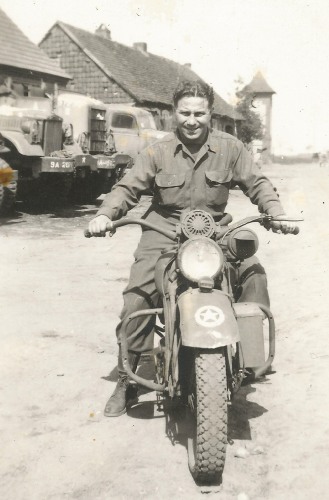 Photo from the Webmaster's Collection |
|
'Ordnancemen
policing the Reims area' |
|
At
the end of WW2, many GI's passed thru Camp Brooklyn near Reims, France
on their way back to the USA. |
'Heavy
Wreckers'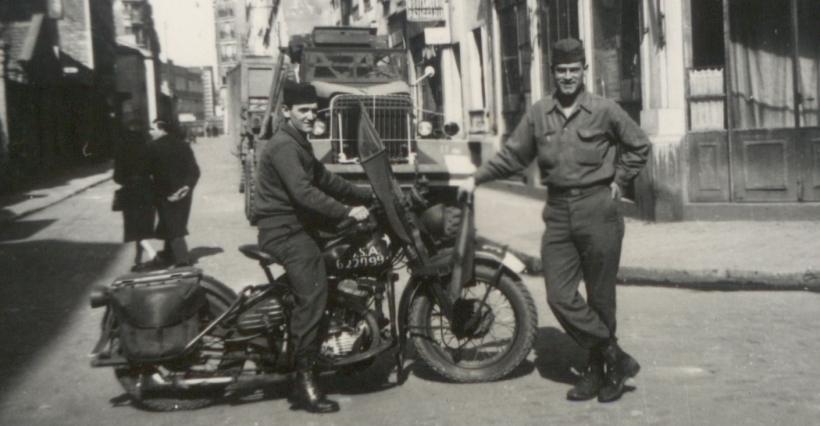 Photo from the Webmaster's Collection |
|
This WLA was
photographed in a French town at the end of the war. Both men wear the wool uniform with either Jump or Double Buckle boots. |
|
'Patrolling
French towns'... |
|
Military Policemen of the 380th MP Battalion take turns posing on a WLA in the French city of Noyon in September 1945.
The war now over, a lot of parts on the bike have been highlighted with
white paint and the Black-Out Driving light has been replaced by two
'pursuit' lights. |
'Berlin
Snowdrop...'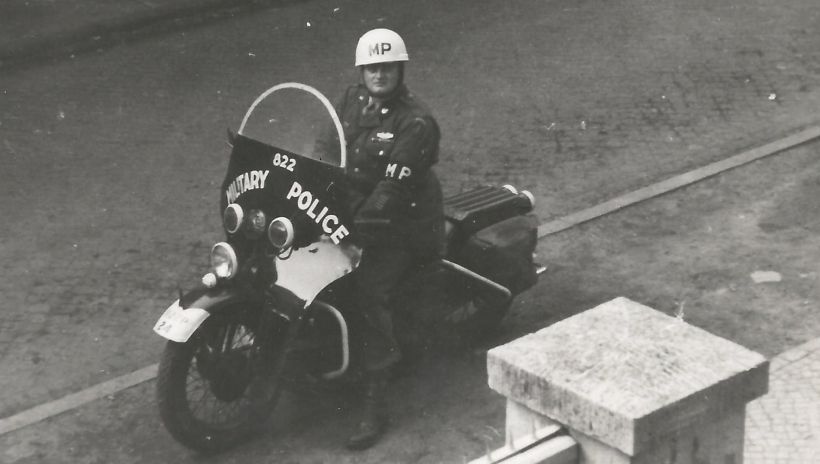 Photo from the Webmaster's Collection |
|
A US Army Military Policeman of the 822nd MP Company patrols the streets of Berlin in the Summer of 1945. The WLA has an added metal windshield and several parts have been highlighted in white along with the MP's British type dispatch rider's helmet which gave the MPs their nickname 'Snowdrops'. The front fender marking shows this is the 24th vehicle of the 822nd MP Company (822P over 24) with the Company number duplicated on the windshield. The rider is wearing the standard US Army wool 4-pocket Service Coat on which the awards show previous combat duty in an Infantry unit. The shoulder sleeve insignia is the US Forces European Theater (USFET) patch which replaced the similar but black SHAEF insignia after VE-Day. |
'The 4
Musketeers'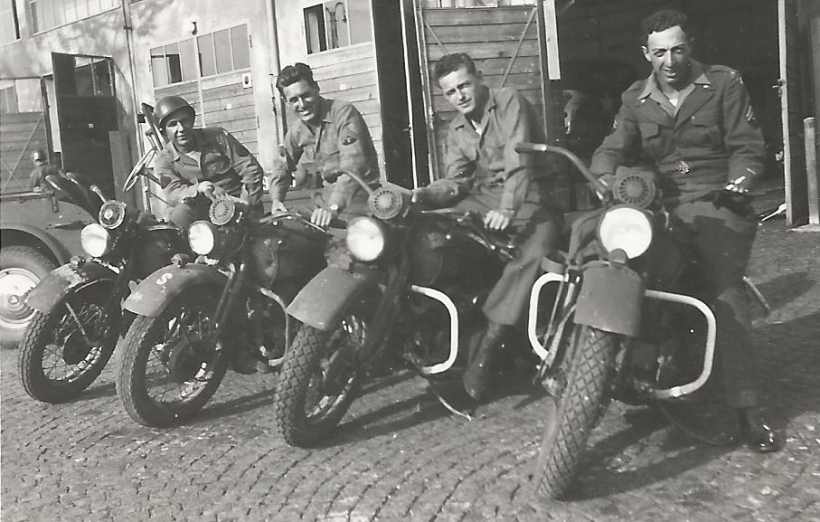 Photo from the Webmaster's Collection |
|
These
GIs from the
3511th Ordnance
Medium Automotive Maintenance Company
were known
as the 4 Musketeers. The picture was taken while on occupation duty in
Germany in the immediate postwar period. No weapons are carried and both
machinegun brackets and ammo boxes have been removed from the bikes. Uniforms are worn in a rather informal fashion. Note the steering wheel, leather seats, chrome hubcap and extended fender on the Jeep in the back... |
|
|
'Italian
Summer of 1945'
A GI rides a WLA in the
Italian sun at Caserta during the Summer of 1945. The uniform of the rider consists of the Summer cotton shirt and trousers. Rank insignia and medal ribbons are barely visible on the shirt. |
'Wiesbaden
Patrol...'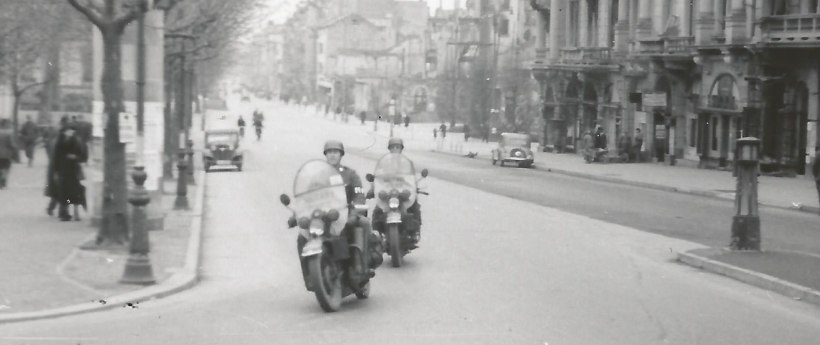 Photo from the Webmaster's Collection |
|
Two American MPs patrol the streets of Wiesbaden, Germany in the immediate post-WW2 period. Both WLAs have High Ammo Boxes and are equipped with both Legshields and Windshield. The Windshield Aprons have been painted white and bear black MILITARY POLICE markings. Pursuit lights have been added to the front forks. Both riders are wearing the Wool Service Uniform with MP brassard and British Dispatch Riders' Helmets. |
'US Forces in Austria'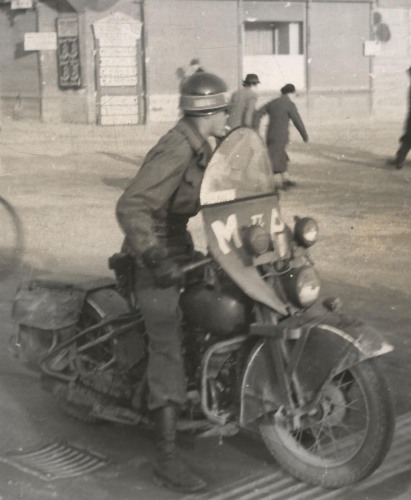
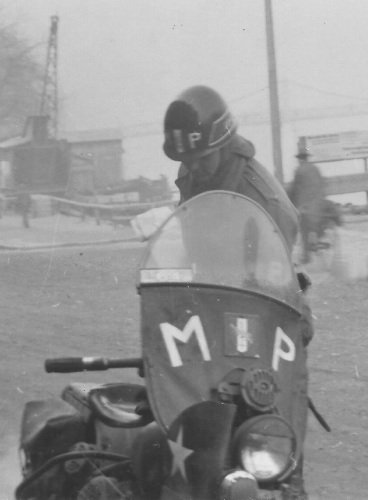 Photos from the Webmaster's Collection |
|
Right after the end of the war in Europe, Austria was divided in four zones which were occupied by the main Allied Powers. The American troops were known as the US Forces in Austria (USFA). Military Police units were amongst the first Americans to be stationed in the country with the 505th MP Bn leading the way. The 202nd MP Company whose main mission was to protect the USFA Headquarters in the capital Vienna and others such as the 524th and 796th MP Bn would soon follow. These pictures show American MPs on motorcycle patrol in Vienna. The WLA
on the left has side skirts
added to the front fender and the tool box is missing. The USFA insignia is
marked on the windshield apron and on a metal plate holding a shroudless BO
Driving Light and extra pursuit light. On the WLA on the right, the windshield
also carries
the USFA insignia between the letters M and P and a white star has been painted on the leather Submachinegun Scabbard in front
of which a pursuit light is barely visible. The horn has been replaced by a
non-WLA model. The occupation of Austria would end in 1955 with the Austrian State Treaty after which all foreign troops were withdrawn. |
|
'Me
and my Pal' |
|
Two GI's on their bikes
somewhere in Europe just after WW2.
It's not really clear what type
of WLA they have, but both have first pattern front fenders. It seems some parts
have been taken off and others added. Both are (partially) lacking the Machine
Gun carrier and both sport odd headlights which seem smaller than the Guide
Cycleray models. The bike on the right is equipped with a British military style
rear view mirror of which the glass is already broken. Both riders wear M1943 field jackets with ties and shirts, and the rider on the right has a 'Combat Unit Patch' on his right sleeve, all indicating again that by now the war is over and they belong to the Occupation Army in Germany. |
'Post WW2
Germany'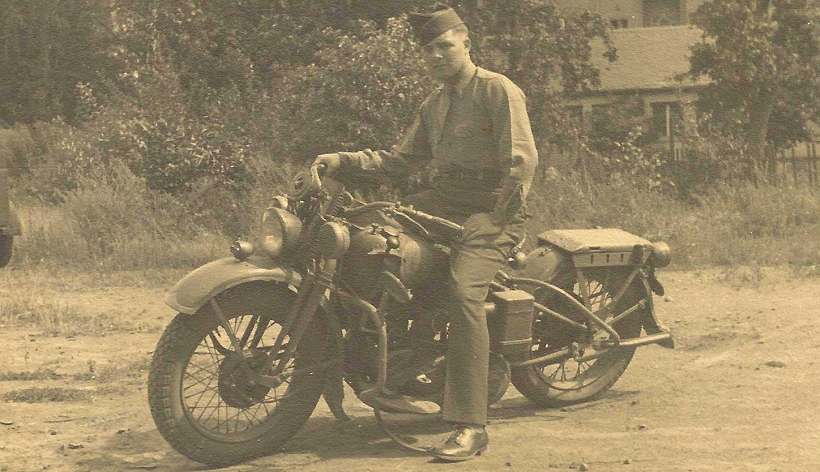 Photo from the Webmaster's Collection |
|
A GI
poses on a WLA in Wetzlar, Germany in 1946. The
SubmachineGun Carrier and Ammo Box bracket have been removed from the
motorcycle which now serves mainly as a patrol and liaison vehicle. Two
pursuit lights have been added and the horn has been replaced. The wool service uniform worn by the soldier is still similar to the wartime pattern. |
For images of
WLAs supplied to other countries under 'Lend-Lease' during WW2, please click
HERE!
WLAs in Magazines and Advertising
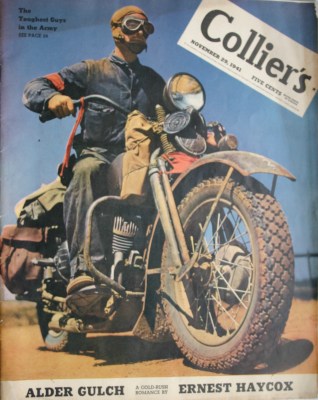
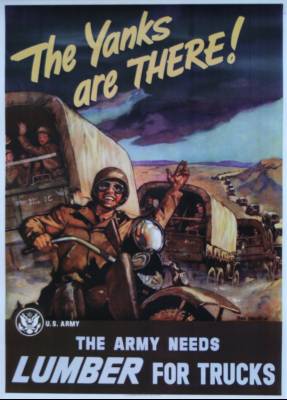
|
The November 29th, 1941
issue of the popular Colliers's magazine featured a 4 page article on the
'Toughest Guys in the Army' and showed several WLAs in action. A WW2 US Army poster expressing the need to conserve wood for the war effort features a 41WLA which is clearly based on the Collier's Magazine cover picture. Note the horn and dust mask under the headlight... |
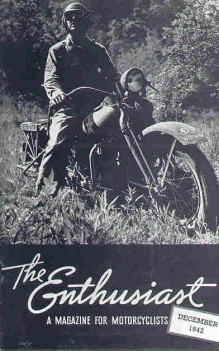
The December 1942 issue of the Harley-Davidson
Enthusiast Magazine featuring another 41WLA on the cover.
|
Although hardly any civilian motorcycles
were produced by Harley-Davidson during WW2;
the Company was determined to let the public know motorbikes would be available
once the war was over.
The US Army Messengers would be the Company's new customers after the war.
Advertisements in magazines made no secret of HD's plans for the future,
while at the same time appealing to invest in War Bonds to be able to
afford a new Harley-Davidson after the war....
Below are ads from 'Popular Science' Magazines from June 1943 and March,
September and November 1944.
Note the 41WLA with Buddy Seats in the first ad and the Army 'E' for Excellence
award banner in the 1944 ads.......
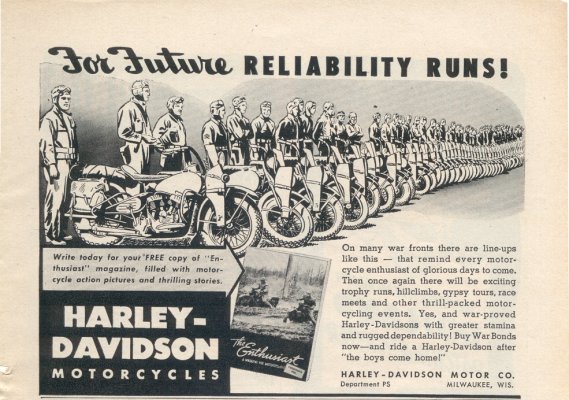
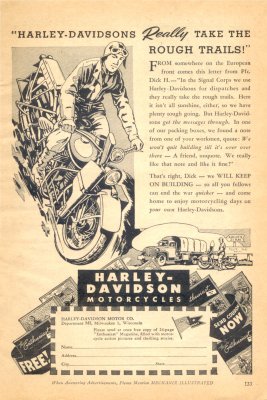
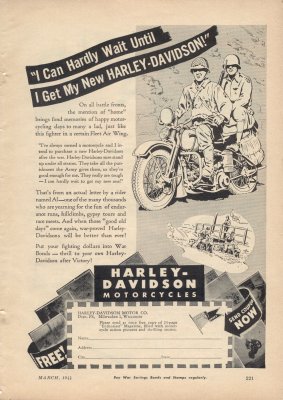
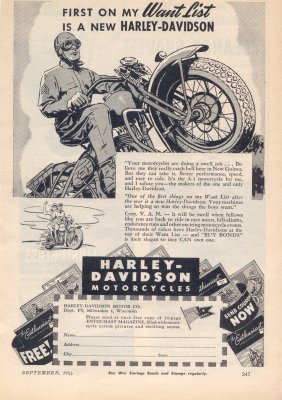
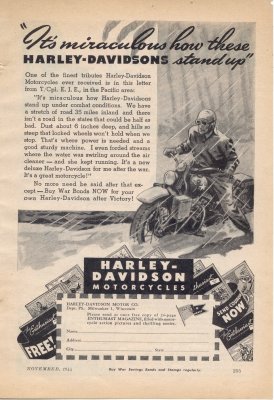
All ads from the Webmaster's Collection
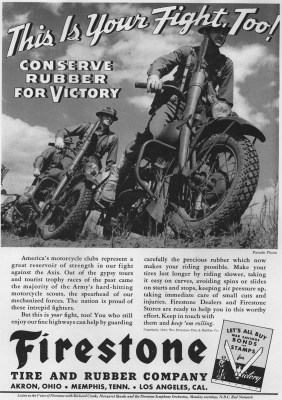
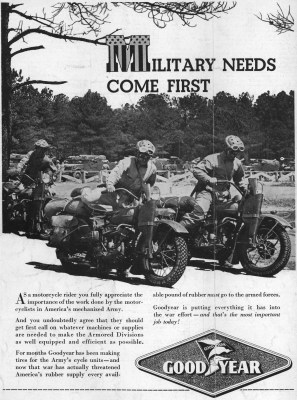
Martin Bogaert Collection
|
WLAs,
in ads for both Firestone and Good Year tires, appeared in 'The
Motorcyclist', |
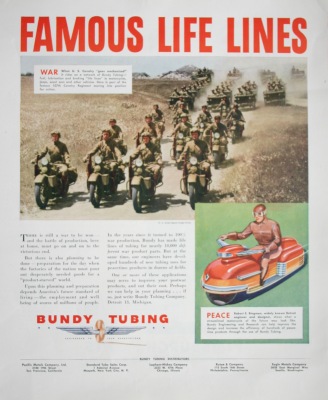
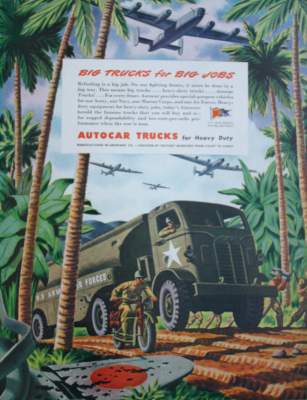
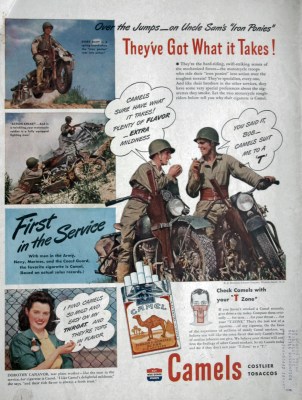
Webmaster's Collection
|
Left: A midwar ad for Bundy Tubing showing
men of the107th Cavalry Regiment on the move in May 1942. Bikes are Type I
42WLAs with
high headlights. |